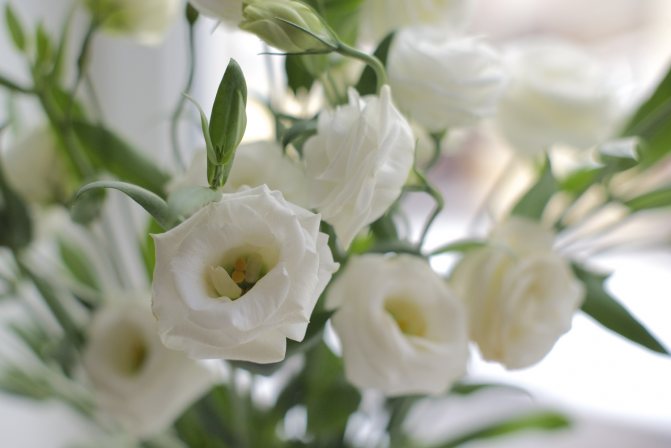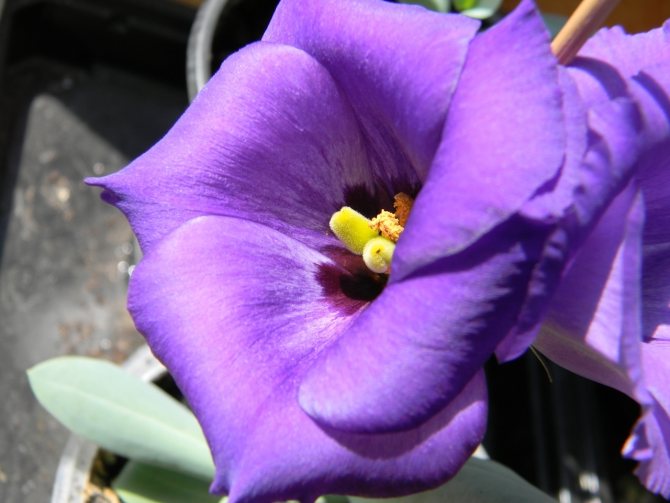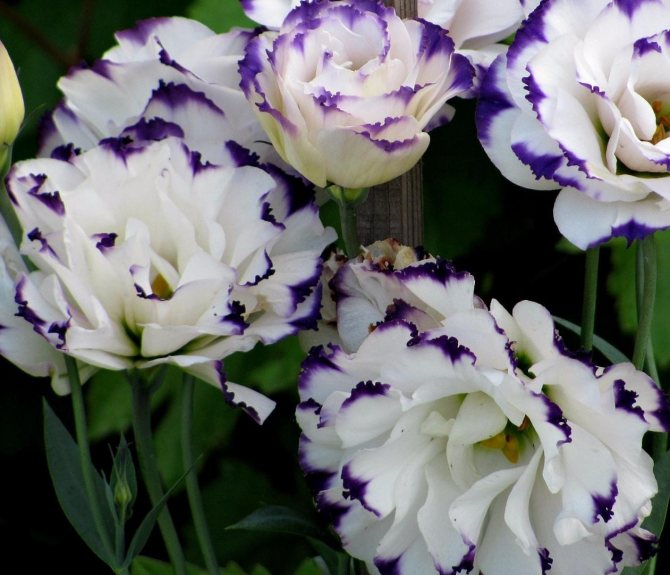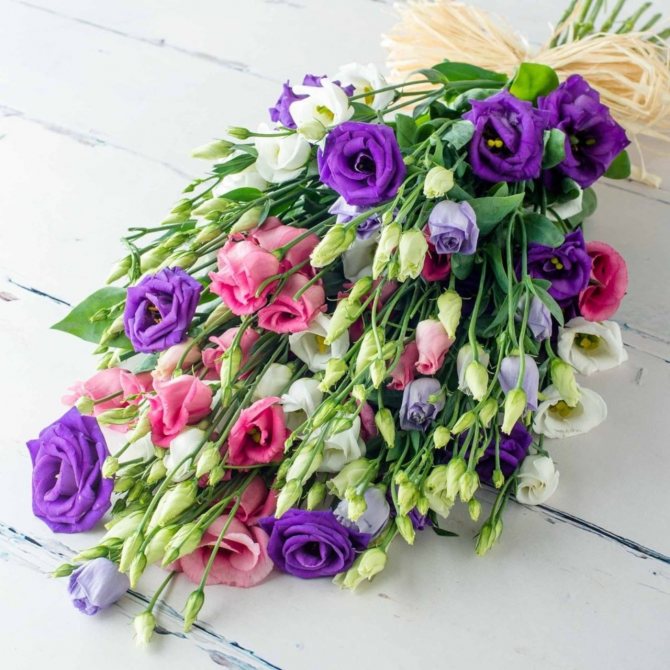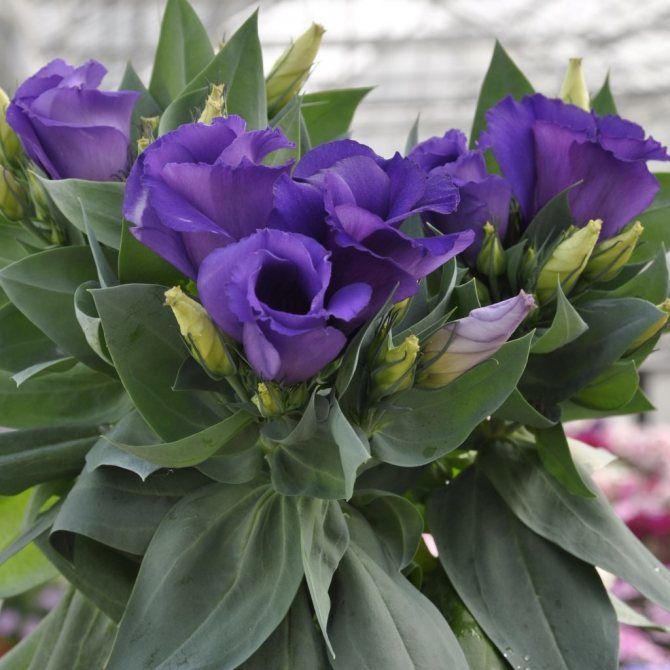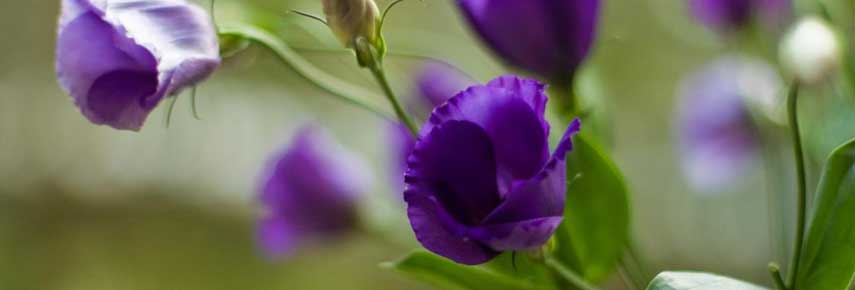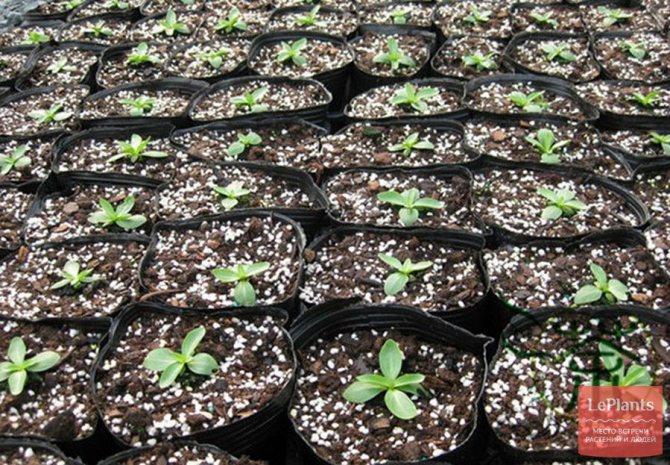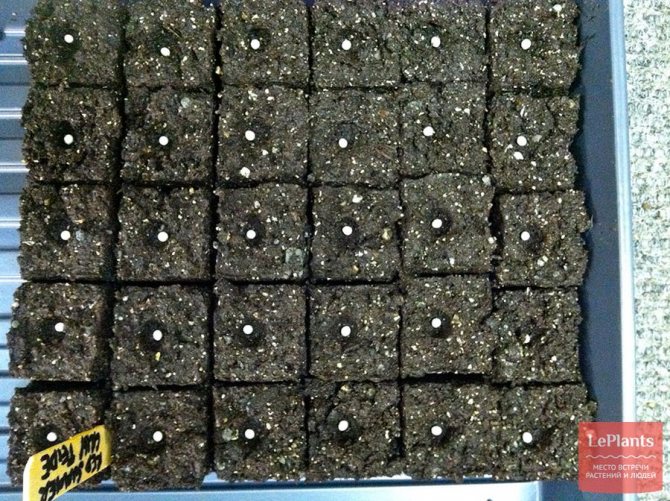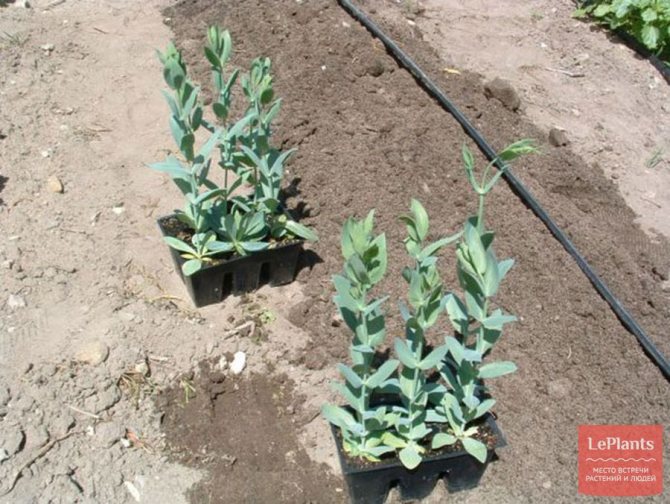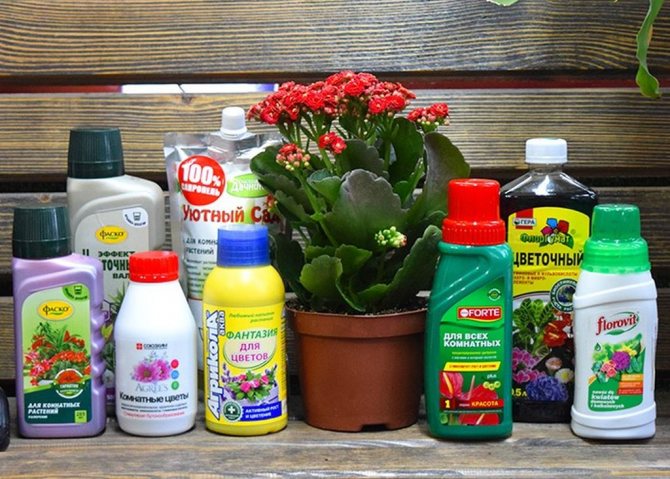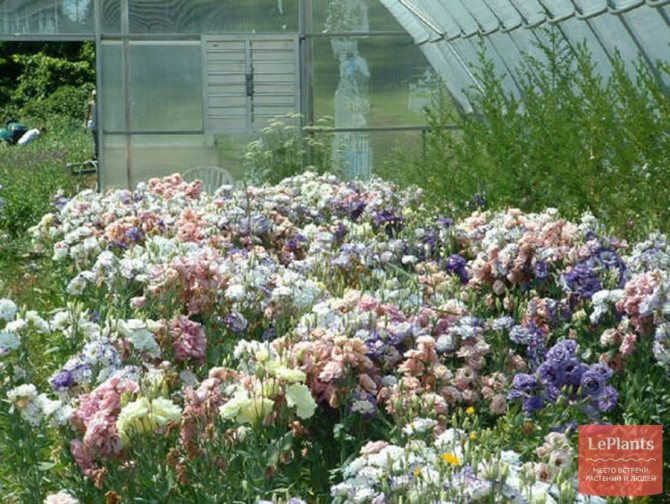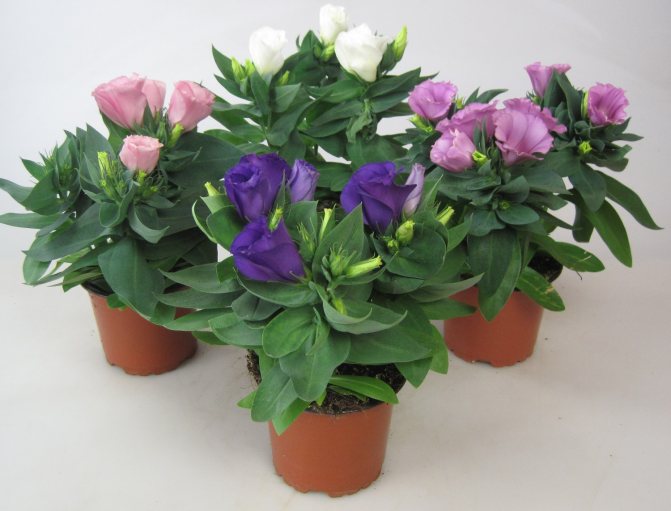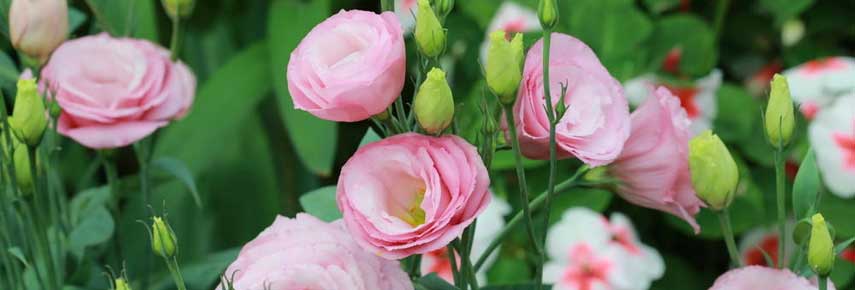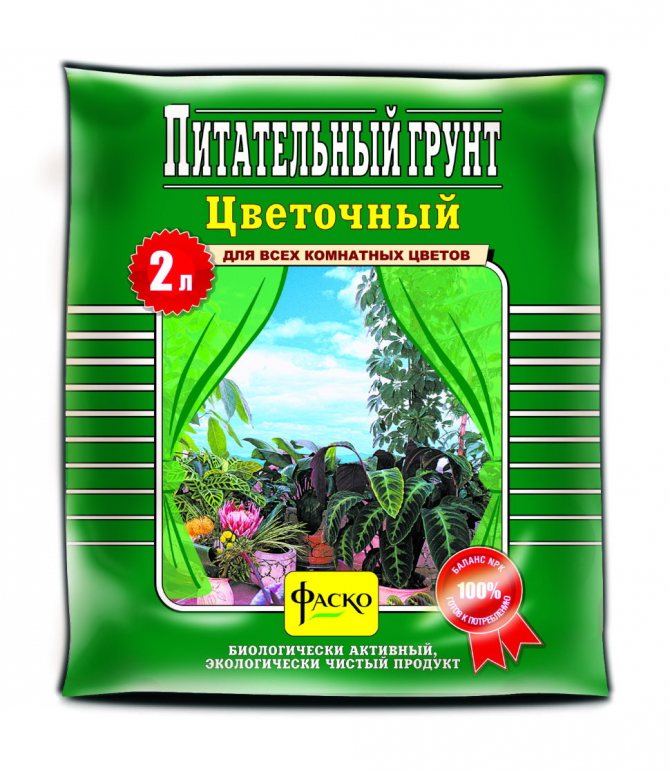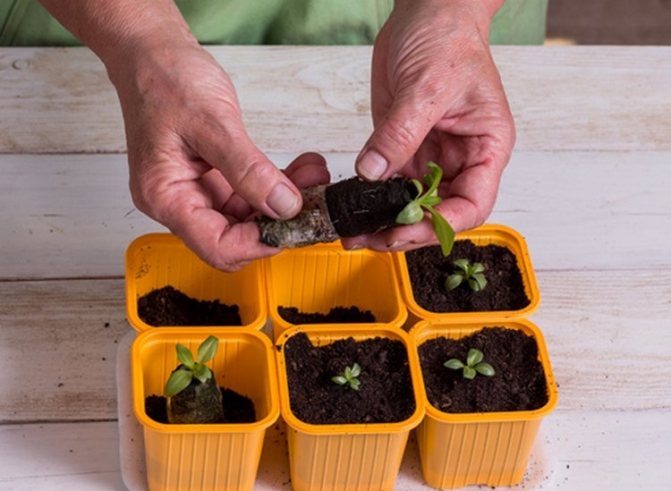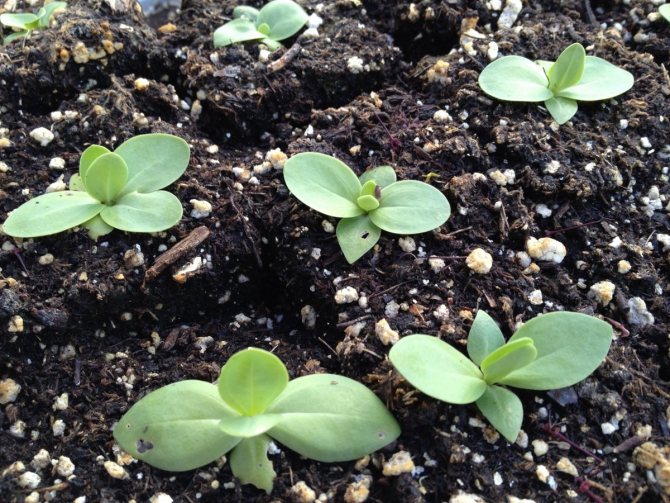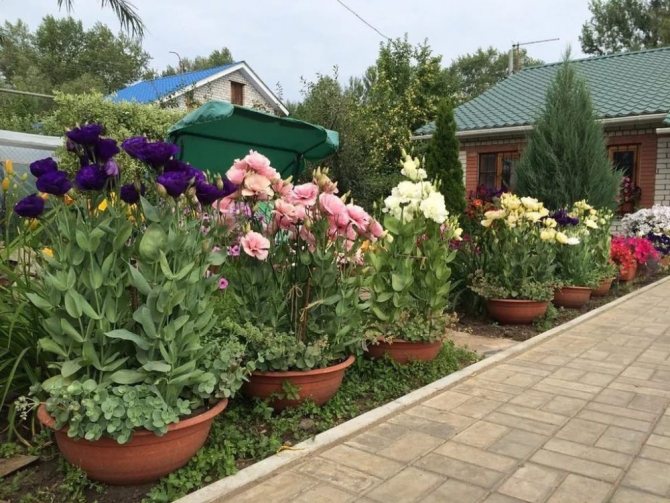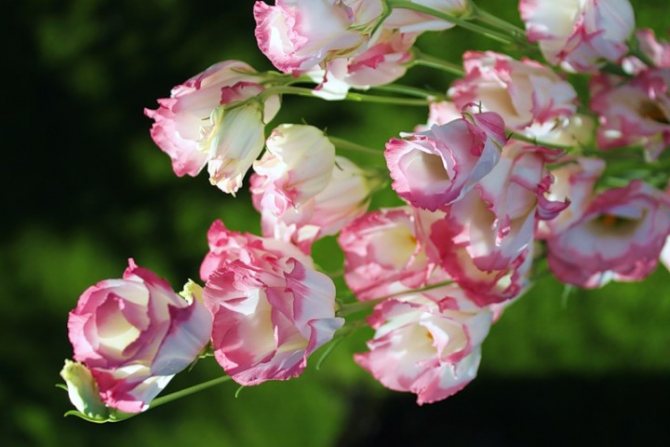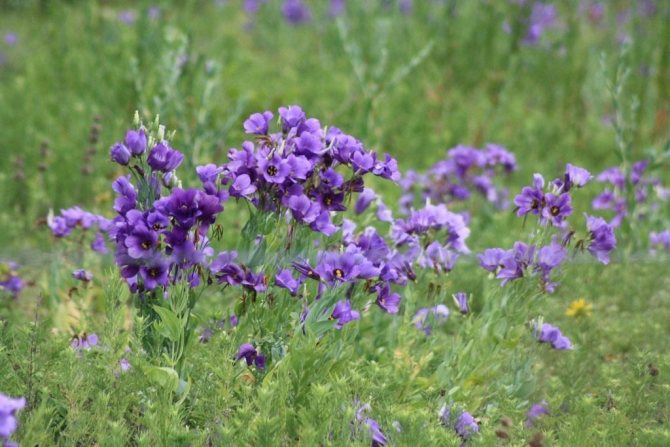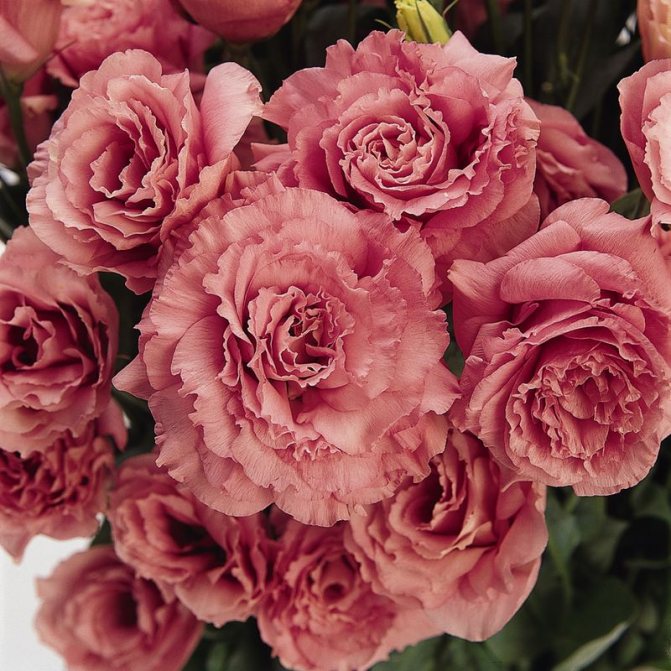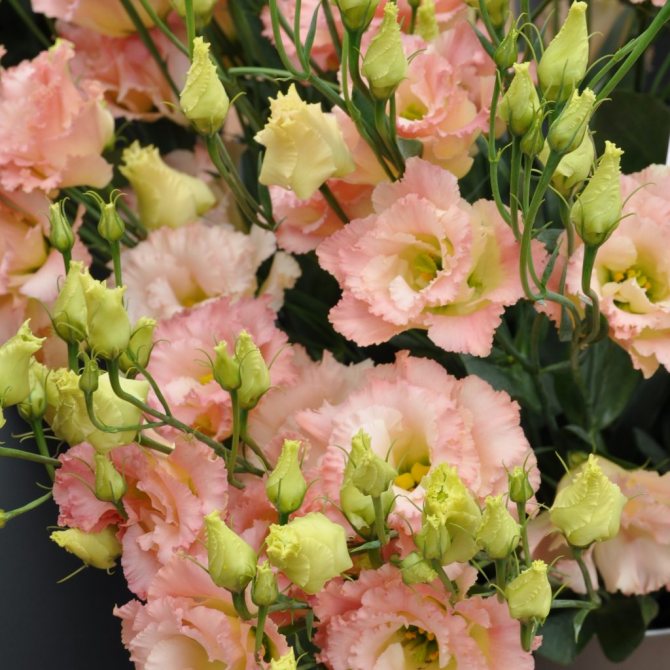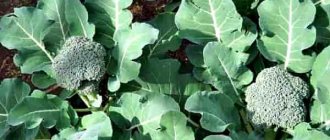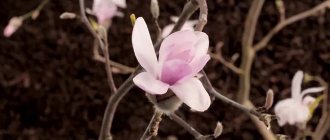A riddle flower or Irish rose, this is how the eustoma is called, will be a great addition to the design of the local area. The plant has a luxurious appearance, it seems that it is difficult to grow it. But this is a mistake.
Lisianthus, as it is also called, is available to anyone with patience. Since planting eustoma with seeds for seedlings, and then taking care of the future decoration will require a lot of effort and time.
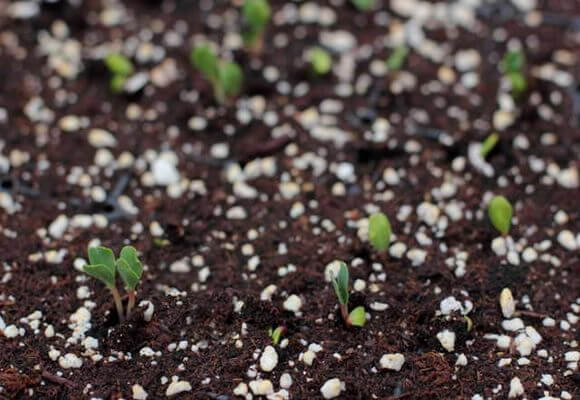
Types and varieties of eustoma
There are up to 60 varieties of the flower in question in the world, but only Russell's eustoma is grown in indoor conditions. There is another similar plant, Lisianthus garden, it differs little from the previous culture. Let's take a look at the description of several varieties of these two types of eustoma.
Potted Eustoma Russell (Eustoma Russelianus)
This flower has a small compact bush, its height rarely exceeds 30 centimeters. Let's get acquainted with the most popular varieties of potted eustoma:
Mermaid variety has simple inflorescences up to 6 centimeters in diameter. The petals are pink lilac or blue, the maximum crop height is 15 centimeters. The bush develops well, does not need to be pinched to form additional lateral shoots.
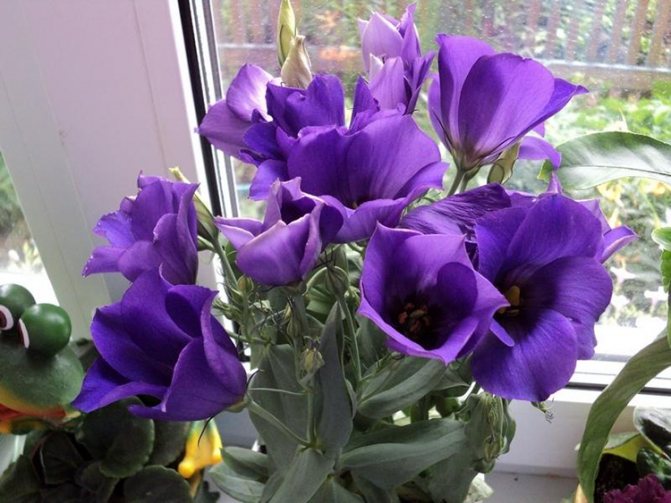

Lisianthus Light Bell up to 15 centimeters in height with small simple inflorescences of different colors. The culture bushes well, does not need to pinch the shoots.
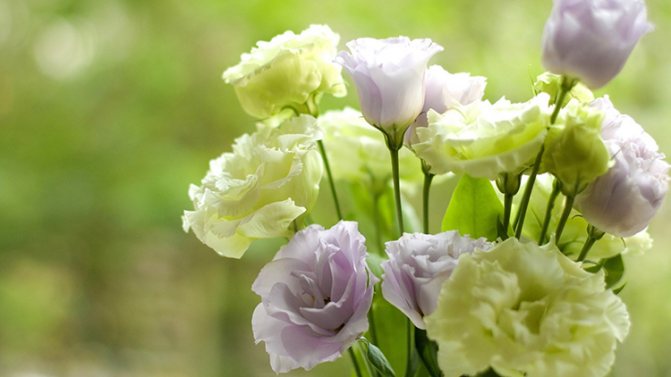

Variety Fidelity Is a beautiful flower with many white inflorescences. A special feature of the culture is the spiral arrangement of the peduncles.


Florida Pink variety a fairly compact bush up to 20 centimeters in height. The inflorescences are pink with simple petals that form a beautiful bouquet.
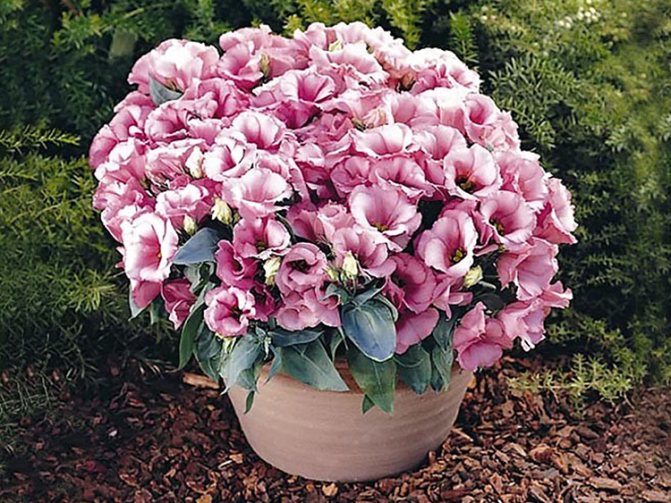

Rozzi variety one of the tallest crops of the species in question, its height reaches 30 centimeters. Terry inflorescences with white, blue or pink petals.
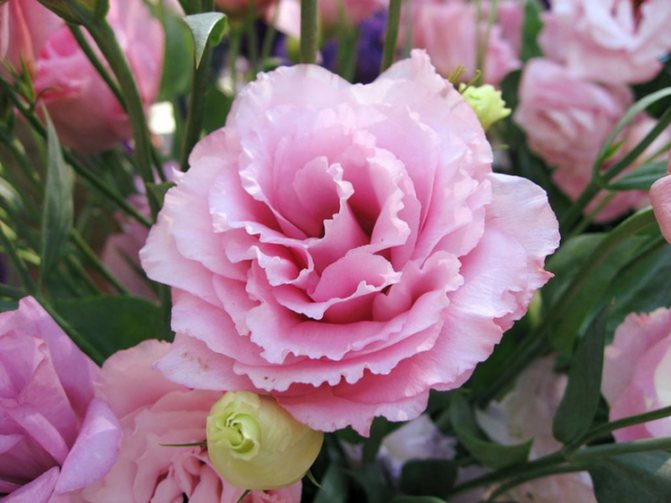

Variety Sapphire with simple or double petals. Inflorescences have different colors, the height of the bush reaches 30 centimeters.
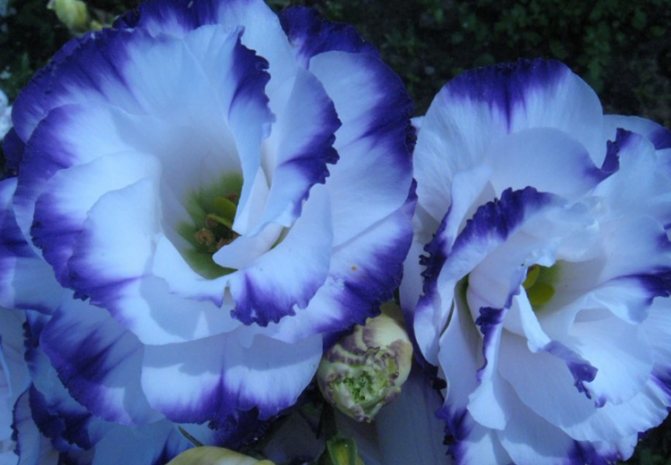

Garden eustoma large-flowered (Eustoma Grandiflorum)
As the name implies, this crop is grown as a garden plant. The flower is quite tall, in appearance it looks like a rose, it is used for cutting and making bouquets. Let's describe the popular varieties of large-flowered garden eustoma:
Variety Aurora terry lisianthus reaches 1.2 meters in height. Inflorescences of white, blue and pink shades. A feature of the flower in question is the early formation of buds, it blooms two weeks earlier than the rest.
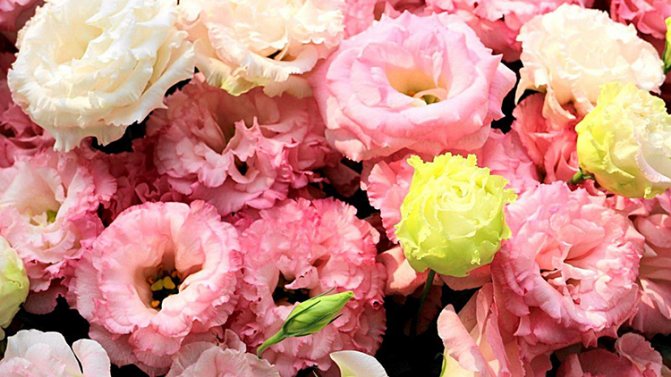

Echo variety with spreading dense stems up to 70 centimeters in height. It blooms early, forms large inflorescences, petals have 11 different shades.
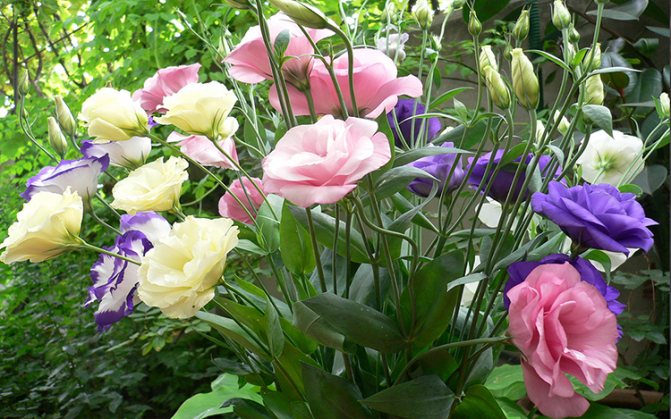

Heidi... A medium-sized variety with numerous simple inflorescences, made in 15 different color combinations. The height of the bush does not exceed 90 centimeters.
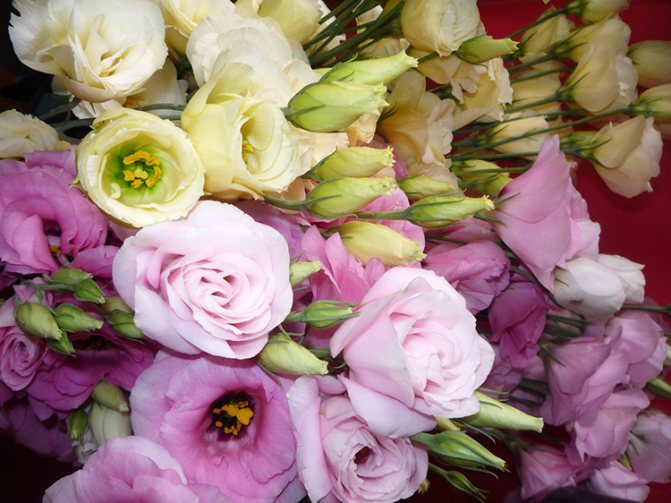

Eustoma Flamenco up to 1.2 meters in height. The culture has powerful, well-developed stems and simple, but large inflorescences, their diameter reaches 8 centimeters. The main advantage of Flamenco is that it is easy to care for.
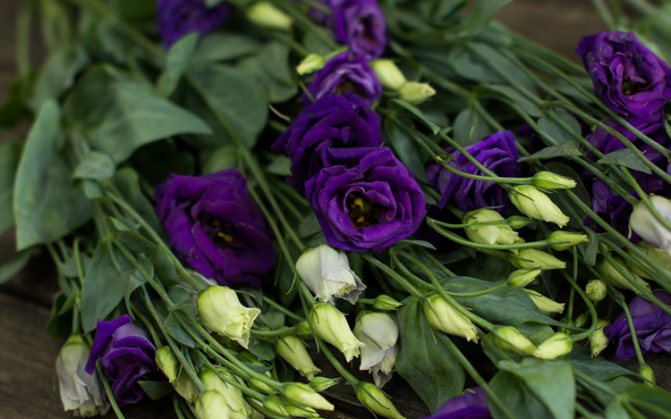

Twinkie variety with simple inflorescences. Bushes up to 50 centimeters in height with pink, purple and yellow petals.


Double White... Terry variety with white inflorescences, a bush up to 70 centimeters in height, has powerful erect shoots. Differs in undemanding care.
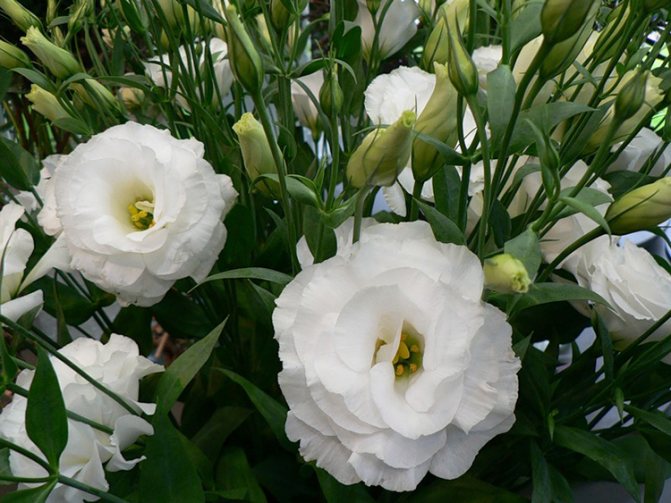

Practical advice
There are several "secrets" with which you can increase the number of flowers on one stem and extend the flowering time.
- As soon as 6-8 true leaves appear on the stem, pinch the top. This stimulates it to branch, one plant will give an increased number of flowers.
- During active growth, feed mainly with nitrogen fertilizers, they have a positive effect on the growth of green mass. Fertilizers with an increased potassium content can be used for the root system. If there is ash - great, if not - use commercial preparations for feeding flowers.
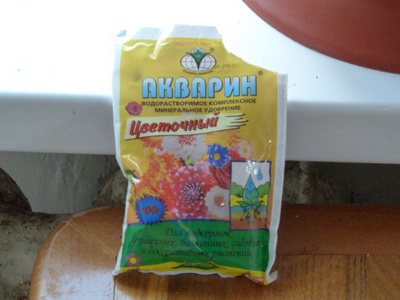

Fertilizers for flowers - The beginning of flowering is regulated not only by the time of sowing the seeds, but also by the time of transferring the seedlings to the garden or to the flower garden. If the weather changes in the direction of lowering the temperature, then do not be too lazy to make the simplest shelters over the bushes. These can be ordinary curved rods with a film, covering geotextiles, etc. Sharp temperature fluctuations, albeit within the values permissible for a plant, not only postpone the appearance of flowers, but also cause death.
- Plants have been preparing for winter since the end of summer. Some varieties can withstand significant frosts even during flowering. The main condition is proper care for them.
- If flowering is over too early, re-bud formation can be stimulated. To do this, you need to cut off the wilted flowers, after one and a half to two months the eustoma will give another wave of flowers.
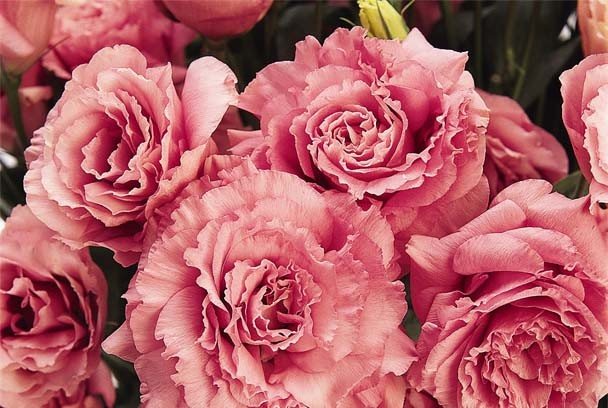

Blooming terry eustoma - There are plants that can be watered both from the top of the pot and into the pan. There are plants that require watering only from the bottom. The eustoma is watered only on top of the pot. And in the pot it is imperative to do land reclamation. To do this, use small stones, the layer thickness is at least two centimeters. An excess of moisture is the main enemy of the plant.
Each advice must be used wisely, be sure to take into account the peculiarities of plant growth. If you decide to grow flowers for sale, then the technology changes somewhat. The closest attention is paid to compliance with watering and feeding regimes. Breeding in greenhouses makes it possible to regulate important parameters of the microclimate, and to fully automate the control of soil moisture and the frequency of irrigation. Flowers are cut to the roots, and then new generations are grown.
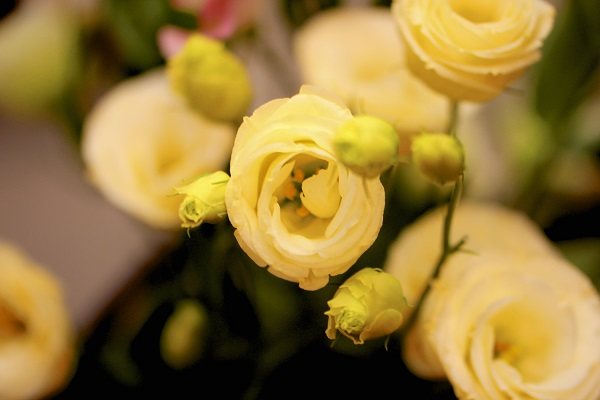

Large-flowered eustoma
Planting eustoma for seedlings
The seeds of the culture in question are quite small, they go to stores in the form of pills. You can collect your own seeds if you have these flowers on the site, but in this case, the difference between the parental and subsequent forms will be more and more felt every year.
The pelleted seeds do not need preliminary preparation, because their shell already contains a sufficient amount of microelements and other nutrients.
Soil for eustoma
We prepare the soil for sowing seedlings from equal parts of peat, garden soil and sifted sand. In the end, you should get a soil with a neutral acid reaction. From store mixes, you can use soil for Saintpaulias.
Before moving into seedling containers, the soil is disinfected in a solution of potassium permanganate or placed in the oven for 30-40 minutes. There, the earth is calcined at the maximum temperature. Sowing capacity can be special plastic boxes, disposable plastic cups or peat humus pots. Drainage from small pebbles is placed in the boxes and only after that the nutrient substrate is poured.
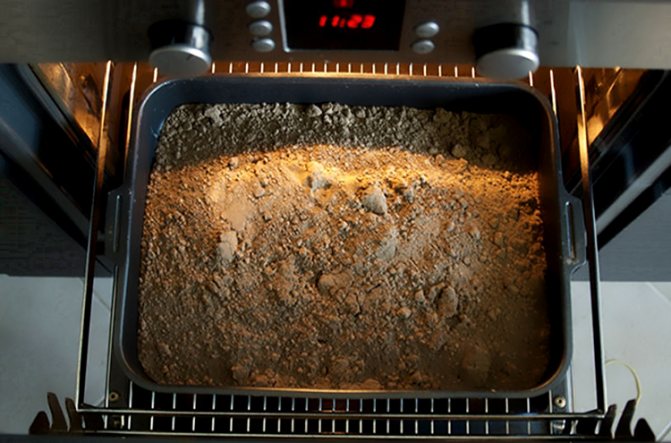

Seed germination should take place in the light, so the seeds are placed on slightly compacted and moist soil, but they are not sprinkled with soil.To destroy the protective shell, the seeds are lightly sprayed with a spray bottle, then the containers are covered with a plastic bag or glass.
For better germination, seedlings are installed on a windowsill well-lit by the sun in a room with a temperature regime of + 20 ... + 25 degrees.
Before germination, the soil must be moistened with a spray bottle as needed. With the right approach, the first shoots will appear within two weeks from the date of sowing the seeds. Next, they remove the shelter and begin to care for the young plants.
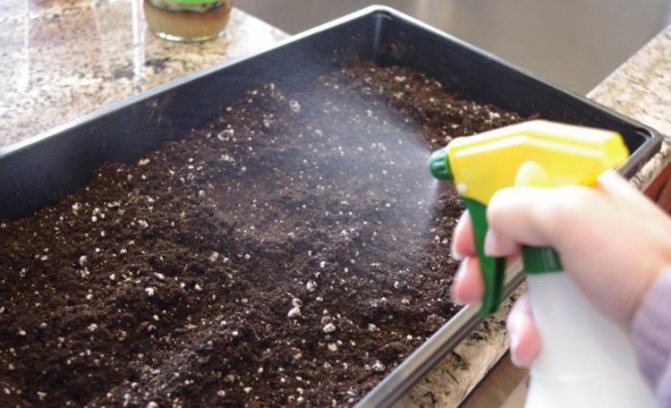

Seedling and seedling care
Measures for the care of hatched seedlings are to maintain optimal daytime temperatures at the level of 20..25 degrees. The room temperature at night should not drop below +16 degrees.
Eustoma seedlings begin to grow at the end of winter with a short daylight hours, so the flowers should receive additional lighting with phytolamps. In general, crops should receive up to 16 hours of natural and artificial light per day. Water the seedlings with a pipette or a small syringe pointwise. To avoid the appearance of diseases, chemicals such as Previkur or Fitosporin are introduced into the irrigation liquid.
At a certain stage of development, flower seedlings may stagnate in growth, but you should not worry. At this time, the root part of the culture is growing, while the aerial part of the flower remains in place.
About 2 months after planting, the first pair of true leaves will appear on the plants, which means that the plants need to be transplanted into a more spacious container, for example, a disposable plastic cup. During the pick, the seedlings are carefully removed from the soil with a toothpick or awl. In the new soil, make a depression with your finger or pencil and transplant the seedling there.
After the diving process, after about 10 days, we apply liquid fertilizers for flowers into the soil. We install the seedlings on a well-lit windowsill, which will prevent them from pulling out from a lack of sunlight. When the seedlings grow up a little, they are dived once again into permanent pots with a diameter of 6-8 centimeters.
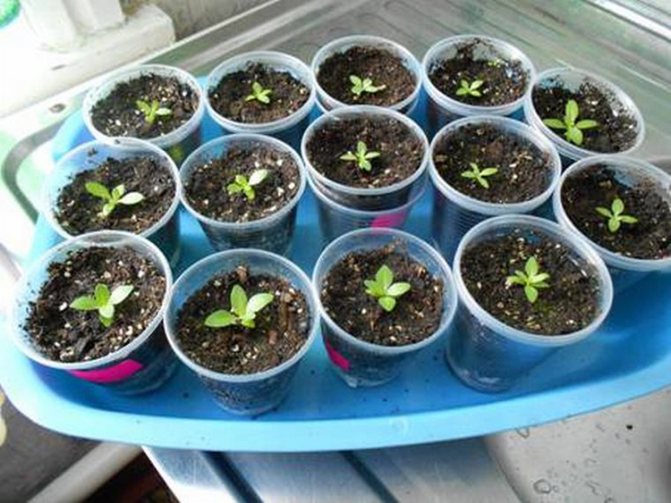

How to grow eustoma in peat tablets
Special tablets based on peat improve seed germination, and picking from such containers for plants is much easier. For growing Lisianthus seedlings, it is recommended to buy washers with a diameter of about 5 centimeters. They are placed in several pieces in a food container and moistened with heated water.
When the tablets increase in volume, it is necessary to drain the remaining liquid from the container and lower one seed to the center of each of them. To accelerate the destruction of the protective shell, the seeds are sprayed with water from a spray bottle. After that, the container is covered with foil or glass and placed on a sunny windowsill. Germination of seeds occurs at a temperature of 20 ... 25 degrees. After the formation of several true leaves, the seedlings of the flowers are moved to a permanent flowerpot.
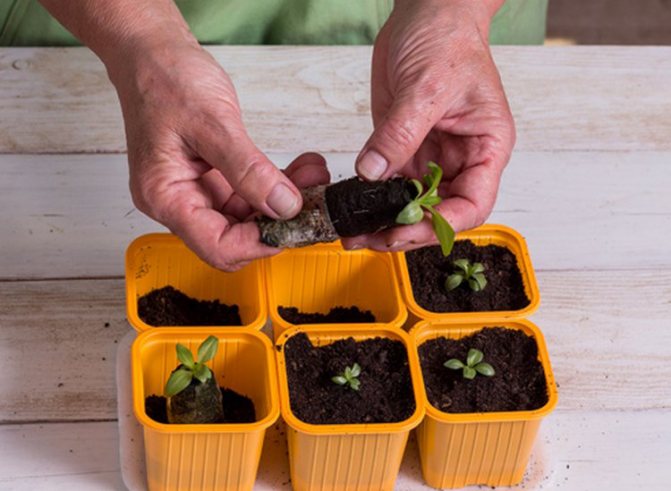

Biological features of eustoma
Before you start growing a flower from seed, it will be very useful to get acquainted with its biological characteristics. Such knowledge will allow you to avoid some mistakes, increase the chances of success in the business you have started. We will give beginner growers one piece of advice - if your seeds did not sprout in the first year, do not lose heart. Analyze your actions carefully, find mistakes and start over. Be sure that the result will justify all your efforts.
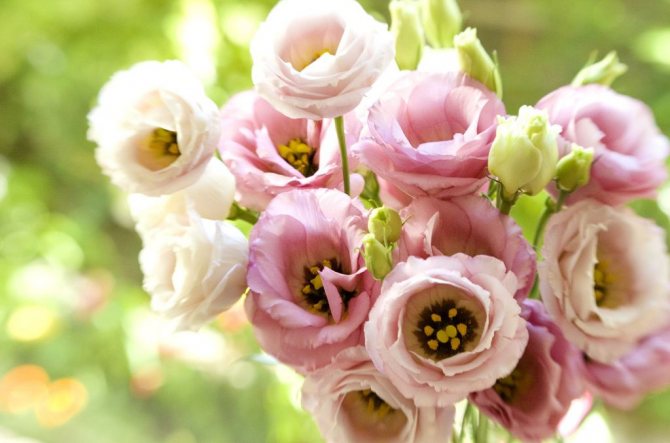

Beautiful eustoma
- Plants love even, diffused light. Do not keep it in the shade as well as in the sun. Sunlight is useful only during seed sprouting, its rays stimulate the awakening of sprouts.
- The optimal soil is mixed in equal proportions with humus from the bark of deciduous trees (you can take coconut) and peat.
Important. Check the acidity carefully, it should only be neutral.
How to check the acidity of the soil at home? Very simple. Place a few drops of vinegar on the soil to be examined. If bubbles begin to appear, it means that a chemical reaction is taking place between vinegar and lime in the ground, the soil is neutral or slightly acidic. In acidic soil, the presence of "own acid" has already used up all the lime, chemical reactions with the release of hydrogen oxide do not occur.
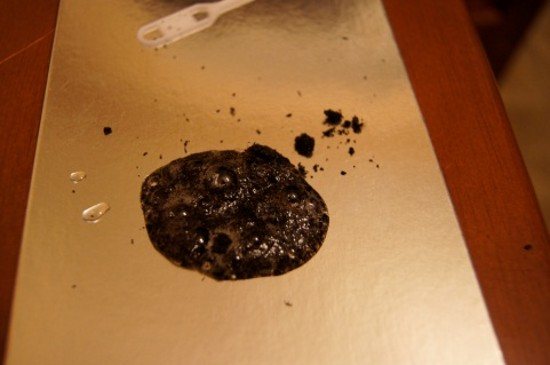

Neutral soil acidity - there is a reaction with vinegar
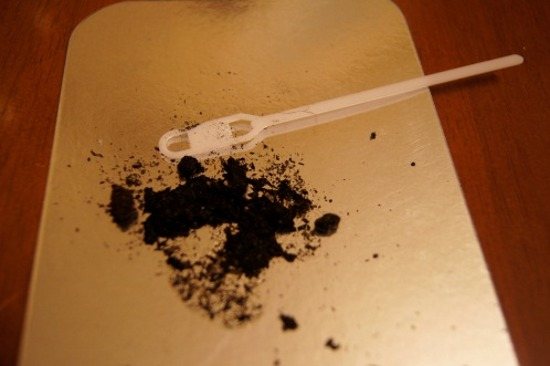

Acidic soil acidity - no reaction with vinegar
- Do not try to propagate eustoma with cuttings, they will never give a root system. The method of dividing one bush into several will not work either. Even on large plants, the root system is so underdeveloped that it will not tolerate any separation, both bushes will certainly die. For the same reason, the flower cannot be transplanted.
- In order to increase the flowering time at home, the plant should be kept in a cool room.
Consider these features of plant development and avoid annoying troubles.
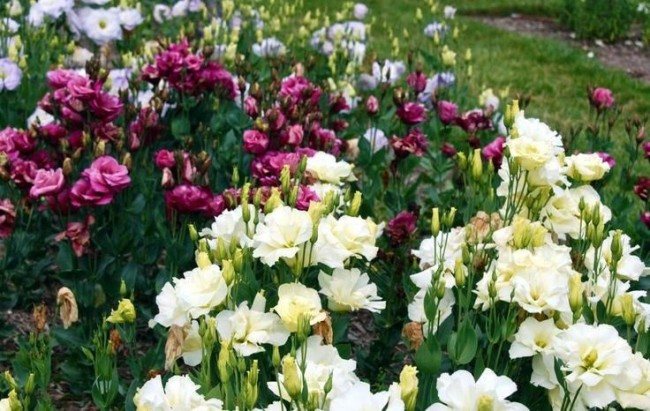

It is best to plant eustoma with seeds.
Growing potted eustoma
In order for the Irish rose to develop well, it is necessary to create favorable conditions in the apartment. Let's get acquainted with some of the nuances of growing this plant.
Eustoma transplant
An adult flower may grow to a considerable size and will need to be moved to a new larger container. Eustoma does not like transplants, so the procedure must be carried out with special care. Plants are transferred from pot to pot, poured in a new nutrient substrate and watered with warm water.
Eustoma care at home
Caring for lisianthus in apartment conditions consists in timely pruning and feeding of plants, maintaining the necessary humidity in the air and soil. Let's take a closer look at these procedures.
Watering and feeding
In the summer, the flower needs regular watering, but with the arrival of winter, their number is reduced. During this period, each subsequent watering is carried out when the topsoil dries up to a depth of 2-3 centimeters. For the implementation of the procedures, a soft rain or settled tap liquid is used. The culture needs high humidity. To do this, you can install a container of water next to the plant or spray the liquid near the flower.
If water gets on the leaves and stems of plants, it can cause sunburn of the plants, so the water should be poured only at the root.
Fertilizers for lisianthus are applied at intervals of two weeks. For this purpose, special store-bought compositions for flowers are used in the dosage prescribed by the instructions. In winter, nutrients are not added to the soil. During this period, the plant should be dormant.
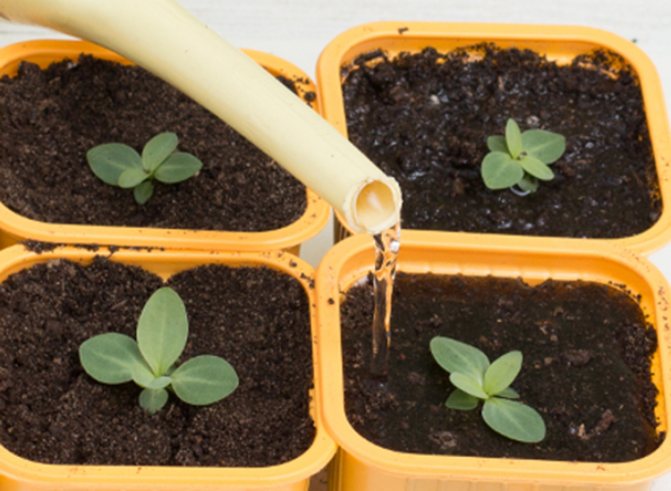

Lighting and temperature control
During development, the flower must receive a sufficient amount of heat and light. An adult culture will delight its mistress for a long time with a lush, long flowering, if the flowerpot is placed on a windowsill well-lit by the sun. Lisianthus prefers bright, but diffused light. In this regard, the plant must be placed on the windowsills of the east or southwest windows. In case of persistent drought in the summer, the culture needs to be shaded.
When growing eustoma, it is necessary to create a special temperature regime. In summer, this plant feels good at a standard room temperature in the range of + 18 ... + 25 degrees. In autumn, temperature indicators begin to gradually decrease. With the arrival of winter, the flower goes into a state of rest. During this period, it is recommended to take the culture to the balcony or to another room, where you can set the temperature + 10 ... + 15 degrees.
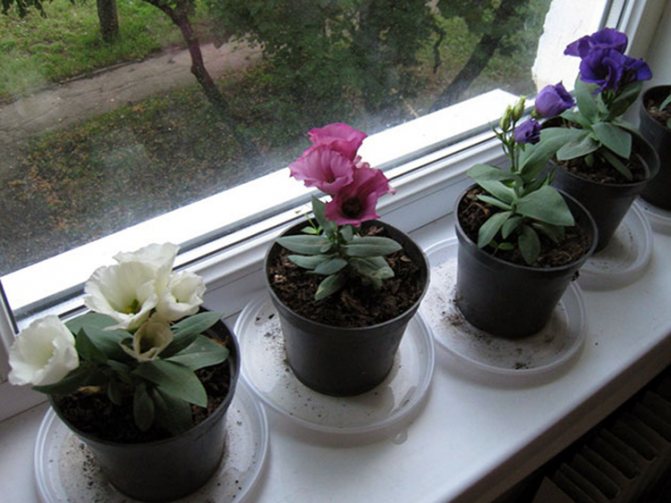

Bloom
If all the rules of care are followed, the first inflorescences on the plant appear 5 months after the formation of the first shoots. During flowering, the gardener must constantly pluck off the faded buds, which not only spoil the appearance of the flower, but also provoke the development of certain diseases.
If the care of the crop is correct and timely, then re-flowering can be observed as early as three months after the first wave of ovary formation.
Eustoma after flowering
At the final stage of flowering, the plant slowly begins to go into a dormant state. During this period, the upper part of the stems is cut off the flower; only two or three internodes need to be left. Further, the culture is moved to a balcony or another room with a temperature regime of + 10 ... + 15 degrees.
Dormant period
The dormant period allows the plant to recover from prolonged flowering. During this period, you need to completely stop all feeding and reduce the amount of watering. Moistening the soil is carried out with particular care. With the arrival of spring, when daylight hours increase, the plant will come to life. New young shoots will begin to appear on it.
At this moment, the flower is transplanted into a new container of large diameter and the usual watering is resumed, as well as nutrients are introduced into the soil.
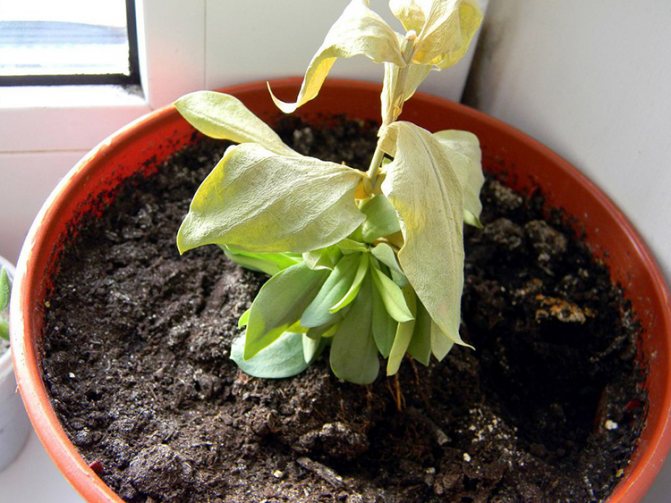

Proper care of flower seedlings
Initially, it is necessary to monitor the room temperature and proper lighting.
Temperature range:
- during the day it should be from 20 to 22 ° С;
- at night, lower the temperature to a maximum of 14 ° C.


The right light allows you to activate all living processes. The plant should be in good light for 12 to 14 hours a day. An artificial light source is recommended.
Watering also affects the correct development of seedlings. It is necessary to monitor the regularity of soil moisture and avoid excess moisture. At the end of the day, the foliage should be practically dry. Waterlogging can provoke root rot, after which the flower sprouts may die.
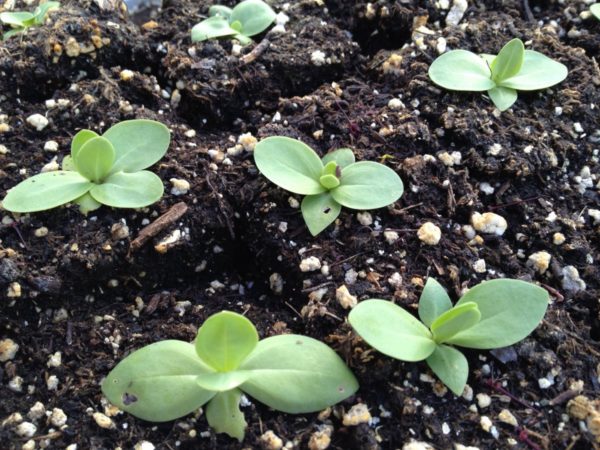

After one and a half or two months, the eustoma will grow to 4-5 centimeters. In this state, it should have 2-3 pairs of leaves. When this is achieved, it is necessary to transplant the germinated plant into personal vessels with a diameter of 5-6 centimeters. The soil is used the same as when sowing seeds.
Growing eustoma in the garden
Growing a flower outdoors is a little different from caring for a potted crop. Let's take a look at the details of such a process.
What place to choose for growing eustoma
So that the specified plant feels good in the flowerbed, it must be planted in the right place. The area for the flower should be well lit by the sun, have fertile soil.
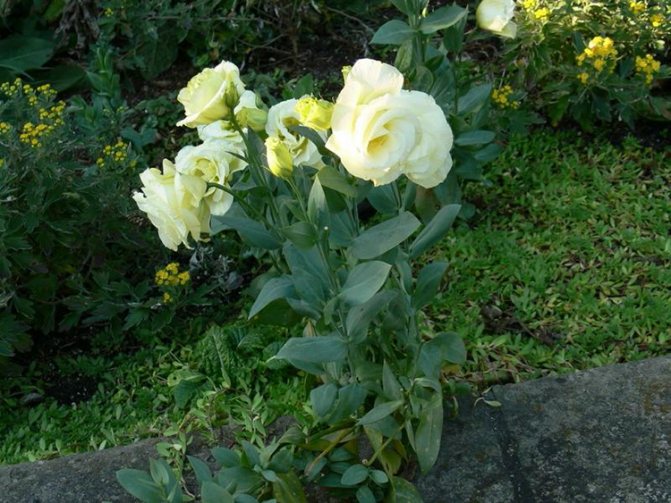

Planting seedlings in open ground
The algorithm for transplanting eustoma seedlings to a permanent place is as follows:
- After the formation of 4-5 true leaves in plants, they can be transplanted into open ground.
- Plants need to be moved to well-warmed soil from mid-May, when the probability of frost return disappears. Attention should be paid to the fact that eustoma is considered a tropical crop, therefore, a decrease in temperature indicators even to 0 degrees can lead to the death of the plant.
- As we have already said, the flower prefers places well lit by the sun, but direct sunlight on the leaves of the culture is destructive. For favorable crop cultivation, it is recommended to select a site close to the crowns of fruit trees.
- Transplanting seedlings to a permanent place is best done in the evening or during the day in the presence of cloudy weather.
- We immerse a seedling with a lump of native land into the previously prepared holes, and water it, then fill the hole with dry earth.
- The flower has a bushy shape, therefore, distances of 10-15 centimeters are left between individual plants in a row.
- After transplanting, the cultures are covered with scraps from plastic bottles or glass jars.
- Approximately 15-20 days after the transplant, the shelter is removed.
Eustoma transplant
Given that the eustoma has quite powerful roots, in mid-March it is necessary to transfer the seedlings into pots 9 cm wide.
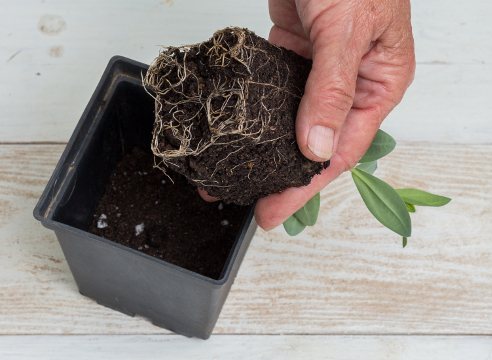

Pour expanded clay drainage into the pots with a layer of about 2 cm, then a layer of soil 4-5 cm.
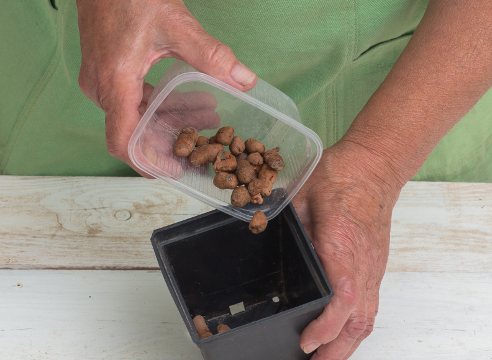

Carefully so that the earth does not crumble, remove the clumped eustoma seedlings from the small pot and place it in the center of the large pot.
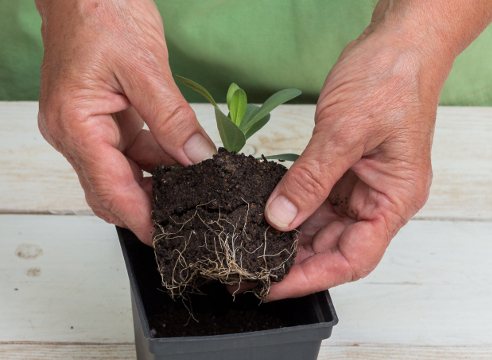

Fill the remaining voids with soil, gradually compacting along the walls of the pot. Do not deepen or expose the root collar. Water the eustoma seedlings after transplanting.
Garden and greenhouse eustoma care
When grown outdoors, Lisianthus needs special care. The fact is that this culture reacts sensitively to changes in air humidity and temperature conditions. This is especially true for growing a flower in greenhouse conditions.
Watering and feeding for eustoma
The frequency of soil moisture is regulated by weather conditions. Filling the soil with water, as well as allowing a moisture deficit, is not recommended. Under stressful conditions, the plant not only develops poorly, but can completely stop growing. In the presence of standard weather, the soil should be moderately moist. With persistent drought, frequent watering is necessary.
During the growing season, the culture sucks out a full range of nutrients from the soil, therefore, feeding should be carried out with a special fertilizer, which contains phosphorus, potassium and low doses of nitrogen. A complex mineral fertilizer, for example, ammophos, is best suited for this.
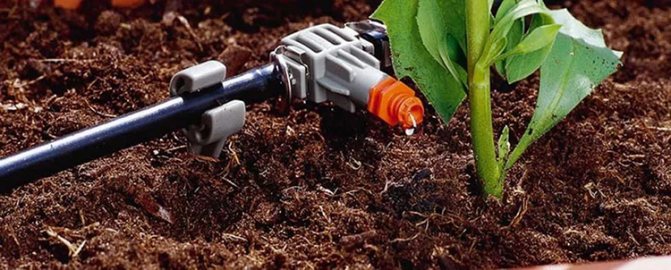

Top dressing is applied to the soil every month, during active growth, during the budding period and the initial phase of flowering. If the flowers are grown in greenhouses for subsequent cutting, then at the initial stage of development they are fed with fertilizers, which contain a large amount of nitrogen. After budding, nutrients with high doses of phosphorus and potassium are added under the flowers.
To prevent the soil from drying out, as well as to inhibit the growth of weeds, the soil is mulched with a thick layer of humus or peat.
Some varieties of eustoma grow up to 1.2 meters in height. At a certain stage of development, their stems begin to break off, and with the amia they lie down. To prevent such unpleasant situations, flowers are tied to free-standing pegs or to a trellis.
Cutting for bouquets
Some enterprising people specially grow eustoma for a cut, colorful beautiful flowers allow you to create unique bouquets. Pruning flowers does not do much harm to the plants, after which they will bloom again, but after 2 months. It can be concluded that cutting lisianthus stimulates an additional, more abundant flowering wave.
Eustoma is an unusually beautiful but capricious culture. Subject to all the rules of care, up to 30 inflorescences are formed on each plant. Under natural conditions, such flowers are pleasing to the eye for 2 months. A cut branch of Lisianthus can stand in water for up to 3 weeks, but for this you need to regularly change the liquid. Eustoma can be used to create mixed bouquets along with other flowers.
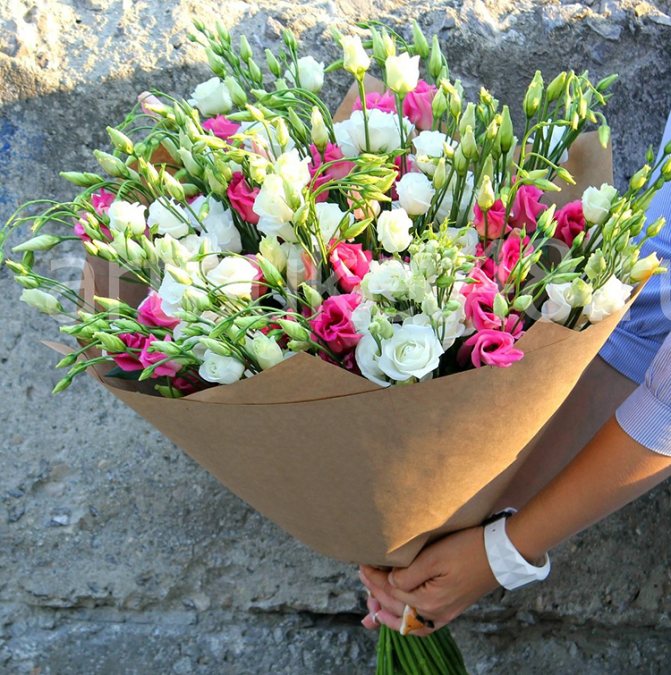

Pruning eustoma
Pruning withering buds during flowering gives an impetus to the formation of a new ovary with a long flowering period. After successful pollination and subsequent drying of the flower, capsules with fruits and seeds are formed on the stems. The seeds are harvested and saved for planting next year.
Cultures that are grown at home are pinched in a pot even during the period of growing seedlings. Such activities will contribute to the development of side shoots and more abundant flowering.
Wintering garden eustoma
Garden eustoma dies during wintering in the open field, but the plant can be saved for growing in the next season. The bushes are carefully dug up and transferred together with a lump of earth to prepared flowerpots. Further, all shoots are removed on the plants, only two or three internodes remain.
During the wintering period, it is necessary to stop all watering and feeding. The air temperature in the room with flowers should be at the level of + 10 ... + 15 degrees. Standard crop care resumes with the arrival of spring, when young shoots begin to appear on the stems. The process of wintering a garden eustoma, which was previously in an unheated greenhouse, is similar.
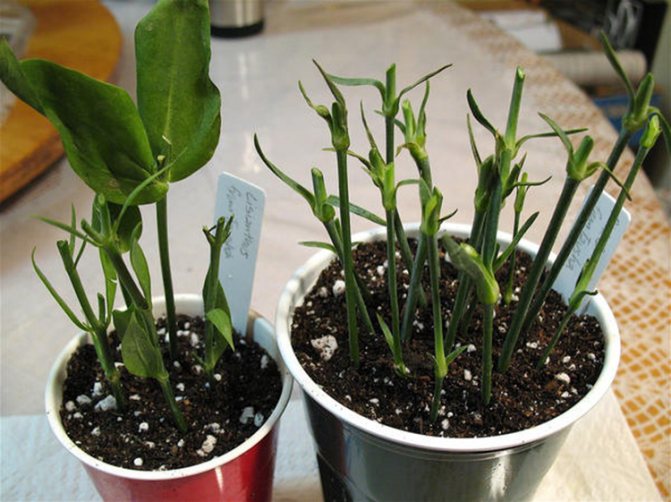

Cultivation of eustoma seedlings from seeds
Growing a flower from a seed is a painstaking process and not everyone knows how or when to sow. Inexperienced gardeners and flower lovers may encounter upsetting moments of this activity, for example, prolonged growth or the absence of seedlings in general. Usually, slow germination is observed when the technical equipment with which the sowing was carried out improperly, or poor quality seeds were used.
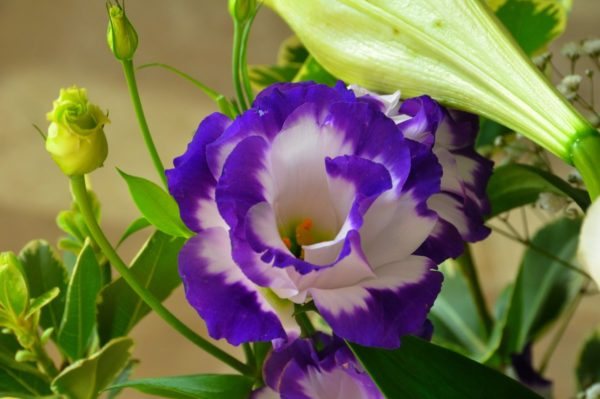

Advice!
There is no need to give up at the initial stage and get upset in case of poor results. It is necessary to think over your actions and repeat the sowing work, taking into account the errors found. You need to buy seeds only in designated stores.
Reproduction of eustoma
The main method of reproduction of a flower is the use of seed. Vegetative methods for obtaining additional plants are used only for selective purposes for new varieties. It is quite difficult to root crop cuttings at home. To do this, you must have special tools and equipment to create special growing conditions.
Flower seeds are small enough, 1 gram of seed contains up to 25,000 grains. When buying, you should give preference to granular seeds, it is easier to work with it (control the seeding density).
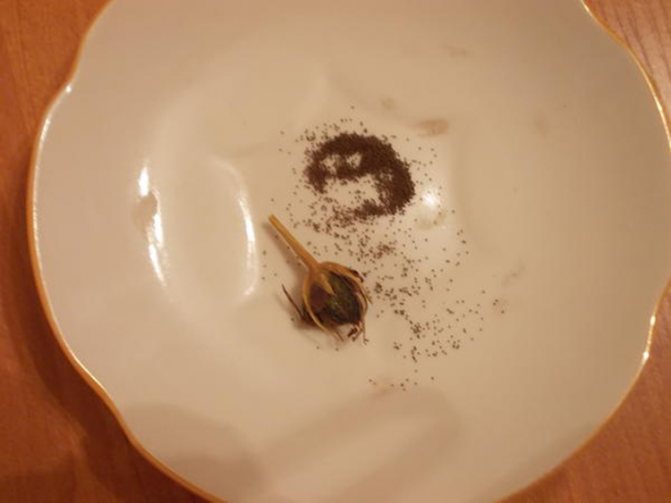

For outdoor cultivation, Lisianthus seeds are sown on seedlings in February or early March. If the flower is used as a pot culture, then the sowing time can be postponed, given the fact that the eustoma will begin to bloom 5 months after the emergence of shoots.
For sowing seedlings, a disinfected soil rich in nutrients is used. To prevent rotting of the root system and implement bottom watering, seeds are sown in pots with drainage and holes for draining excess liquid. Such containers are installed on a pallet. Seeds are germinated at room temperature in the range of 18-25 degrees.
The first seedlings of crops usually appear two weeks after sowing. After the seedlings have 5-6 true leaves, they are moved to individual containers (if the seeds were sown in a common container). After the appearance of 8 leaves, the top of the plant growth is pinched, which will contribute to the appearance of lateral shoots. Seedlings are transferred to open ground in the middle or end of May, when the weather is warm.
Rules for growing eustoma seedlings from seeds
To get seedlings of an eustoma flower for further planting in the garden, cultivation from seeds at home must be carried out from February to March. They should bloom between July and August.
Advice!
In order for the plant to bloom in the winter, sowing must be carried out from July to September.
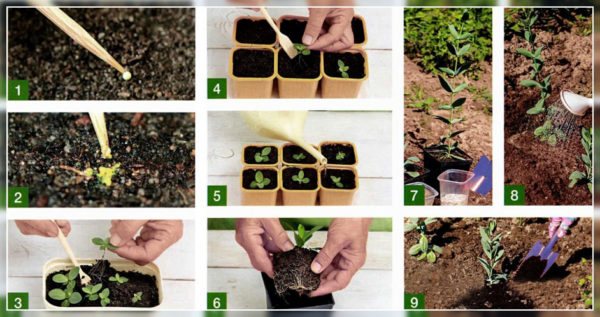

Many people wonder why it is necessary to grow seedlings first, and then the flower itself.
As for eustoma, growing it from seeds at home and then obtaining a plant is necessary for several reasons. The main reasons are:
- growing by dividing the root system will not happen;
- the flower is very fond of moisture and warmth, therefore it grows well at home, after which it goes to garden plots already in a strong state.


Sowing can be done:
- in a large container for several seeds;
- in a separate vessel for each seed;
- in peat "tablets" for seedlings.
It is not necessary to carry out pre-sowing treatment at home before sowing.
Diseases and pests of eustoma
When growing crops in the garden, there is a risk of being affected by various diseases and pests. The main diseases of eustoma are fusarium leaf wilting, powdery mildew, and gray rot.
The main cause of these diseases is considered to be incorrect watering of flowers, the use of cold water for moistening. These diseases are easier to prevent than to cure. The main preventive measure is considered to be soil treatment with foundation, watering the plants as needed and subsequent loosening of the soil.
Black leg is considered another popular culture disease, but it affects flower seedlings. To prevent this disease, disinfecting the soil by piercing in the oven or treating the soil with a solution of potassium permanganate helps.
Among pests, eustoma is affected by microscopic spider mites or aphids. These parasites are transferred to the bush from neighboring plants, they suck nutrients from the leaves, which leads to their curling and further drying out. Aphids can be destroyed by spraying the crop leaves with ordinary soapy water. The spider mite is afraid of insecticides and the influence of dry air.
Even a novice florist can grow eustoma, both in the garden and indoors. Apply the knowledge gained in practice, adhere to the technology of plant care throughout the entire growing season, and the culture will thank you with beautiful, abundant flowering.
Tips for caring for plants at home
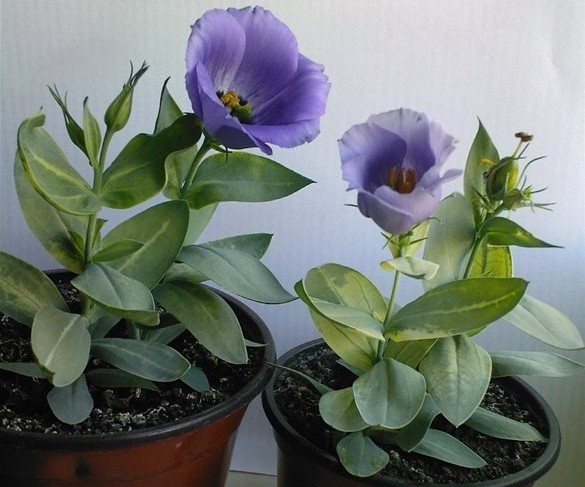

Eustoma: growing at home
The plant is quite capricious and reacts very quickly to deteriorating conditions. Fresh air is always needed, but drafts should not be allowed. In addition, flowers do not like direct sunlight; choose the location of the pots in such a way that the light is diffused. The optimum temperature is approximately + 22 ° C.


Eustoma on the window
As for irrigation, water from city networks should be defended for at least a day. The root system does not react well to the presence of a large amount of calcium ions in the water, it is recommended to water it with soft water. Waterlogging and drying out of the soil become stress for plants, such situations should not be allowed. During intensive vegetation, especially during bud formation and flowering, plants need to be fed. It is better not to experiment on your own, but to use purchased liquid fertilizers. Follow the instructions for use, do not exceed the recommended rates. If all the care recommendations are followed, then there is hope that in about three months you will be able to enjoy new flowers.
How to prevent disease
In order to prevent lisianthus from being attacked by parasites and diseases, you need to take some preventive measures.
- Saplings, both before and after planting, are best watered with foundation.
- Spray the sprouts with epin or zircon. Thanks to this procedure, you will be able to ensure healthy growth of your shrub, and also prevent it from being dependent on negative environmental phenomena.
- Eustoma home long-term planting and care of a photo showing all the procedures that need to be carried out requires periodic spraying with Ridomil Gold. With this remedy, you will prevent your thornless rose from withering due to fusarium. This problem is also quite common when growing a flower.
Important! But! It is still better not to spray young seedlings, as this can affect their growth.In order for her to feel well after the procedure, wait until at least 4 leaves appear on the sprouts.
How and when to sow seeds for seedlings
If you decide to grow lisianthus (eustoma) in the garden, then you need to know that it is planted in the form of seedlings. In the open field, it is very difficult for seeds to grow into a beautiful bush. First you need to prepare the seedlings, give them time to grow stronger, and then plant them on the site.
First you need to decide on the variety and type of flowers. At the store, pay attention to the seed bag. It must be free of damage and water. The text is well readable, the letters are not blurred. It is better to choose seeds with a note about processing, they will have a higher germination capacity. On average, only about 30-40% of the seeds will sprout from the bag. And this will be quite a good result for this culture.
Seeds for seedlings must be sown in January or February. Then flowering will be in the middle of summer, the flower needs an average of 6 months so that it can form inflorescences.
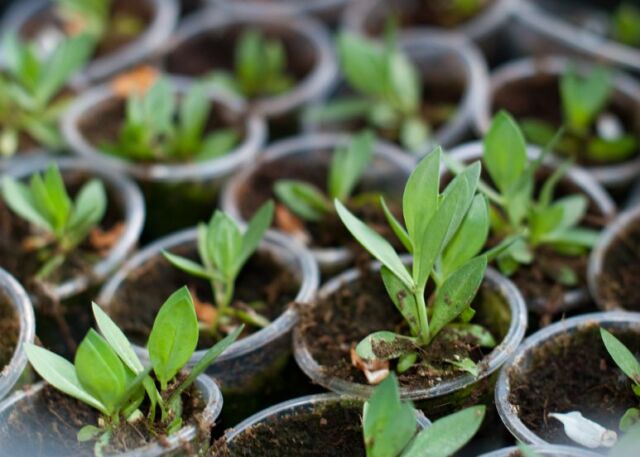

Prepare a seed container, which can be a plastic container or a wooden box. The container should be well washed and disinfected with a solution of potassium permanganate. There must be holes at the bottom for the soil to breathe. It is better to buy the earth in the store, it will immediately contain the necessary set of nutrients.
The soil for sowing seeds for seedlings should be loose, with a neutral acid content. Wood ash will help reduce acidity.
If the soil is taken from the garden, then sand and peat must be added to it. Moreover, the amount of peat should be 4 times more than the amount of land. This culture loves loose light soil.
Since eustoma is easily attacked by harmful insects and diseases, it is necessary to decontaminate the soil a month before sowing the seeds. This can be done by freezing it outdoors (the soil is in the cold for at least 2 weeks), or by piercing it in the oven for 30 minutes.
When the soil is ready, you can start sowing the seeds. If they have already been pre-processed by the manufacturer, then they are immediately sown into the soil. But the untreated seeds are pre-soaked for 30 minutes in a weak solution of potassium permanganate and then dried.


The seeds are spread evenly over the surface of the ground and lightly sprinkled with sand. They should show through a thin layer of sand. You do not need to water, it will be enough to spray with water from a spray bottle. Cover the container with plastic wrap to create a greenhouse effect. But do not forget to remove the film for half an hour every day for airing.
The first shoots will appear after 10-14 days. Now you can remove the film. Watch the soil, it should be slightly damp, periodically water the seedlings from a spray bottle so as not to damage the young shoots.
A pick can be carried out after the appearance of at least 3 leaves. They can be placed in small plastic cups. After diving, it is recommended to feed the plants to make them stronger.
In general, this culture does not like this procedure, and therefore it is better to sow them immediately in separate cups, or to pre-sow them in peat tablets. And as soon as the plant reaches the desired size, transplant directly in this tablet into a separate container of a larger volume.
Site selection
The plant needs a lot of light, light and fertile soil. If the groundwater is close, take care of soil drainage, drainage of rainwater from the site. Remember that the plant has leaves that help to retain moisture, and the increased humidity will only harm it. Try to arrange the flowers in the area so as to protect them from cold winds and drafts.
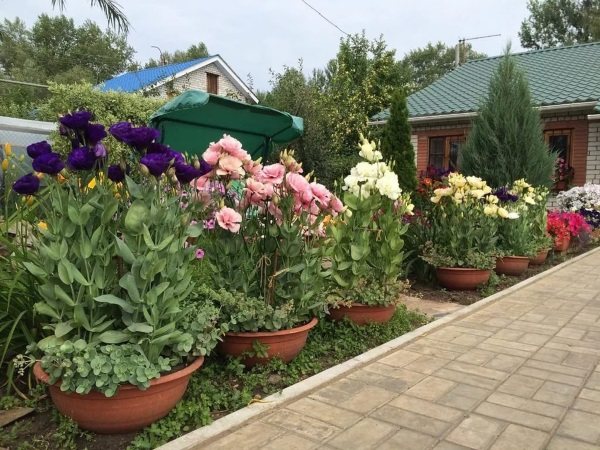

Fertilization, liming
Each gardener has to proceed from the existing conditions of the site, but taking into account the botanical characteristics of the crops. We again draw attention to the "pedigree" of the eustoma, its origin, and prepare a soil similar in composition to the fertile prairies of the Great Plains.
The soil must be prepared in such a way that before sowing, the introduced manure and compost have time to overheat - in the fall, when digging. If necessary, lime is also added in the fall. In the spring, before sowing, it is necessary to loosen the fertile layer, to a depth of 20 cm, with the simultaneous introduction of phosphorus and potassium. These minerals can be added as part of complex fertilizers, a week before sowing or planting seedlings.
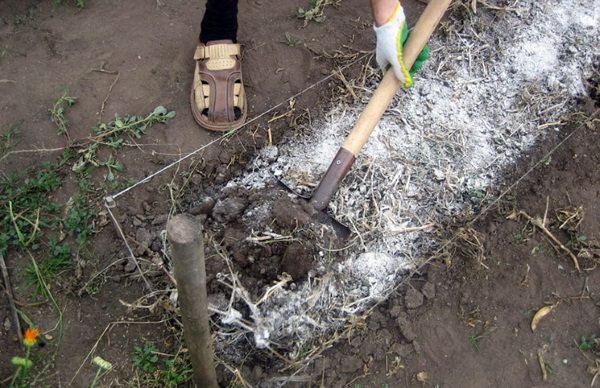

Disinfection of soil as prevention
Take care in advance to protect flowers from harmful microorganisms and pests. To do this, it is enough to prepare a two percent solution of potassium permanganate. The powder must be diluted in ten liters of hot water (500). Spill the area with a hot solution, at the rate of 10 l / 1 m2. The hot disinfectant solution has a double effect: in addition to killing microbes, it drives out pests.
Perennial lisianthus description
perennial eustoma pink
It is an ornamental plant with funnel-shaped double and non-double flowers, as well as gray leaves with a velvet down.
Shrubs have similarities with roses, but differ from them in that they do not have characteristic thorns on the shoots, therefore they received the "name" - a rose without thorns.
A strong stem, starting from the middle, branches out into many shoots decorated with several buds. Thanks to this, just one small branch looks like a full-fledged and original bouquet.
Depending on the variety, an unusual bush can grow up to 90 cm. From July to October, you can enjoy its flowering. In their circumference, the flowers reach up to 8, and sometimes up to ten cm. And when there are still a lot of them on the peduncle, just imagine what a beauty it is!
The main advantage of lisianthus is its long-lasting freshness when cut. Basically, all tall varieties are grown for cutting into bouquets.
The subtleties of growing and using eustoma (lisianthus)
| 1. For growing in the garden, varieties of the Echo or ABC series are best suited. And in a pot culture it is convenient to grow compact varieties of the Florida or Mermaid series. 2. The eustomas bought in the store can also belong to tall varieties, but they are treated with special substances - retardants that inhibit growth, so they remain low. 3. Outdoors, the plant is usually cultivated as an annual, although by its nature it is perennial. In a temperate climate, eustoma does not always winter well. 4. Eustoma flowers retain their freshness in cut for a long time (up to three weeks). Therefore, it is often used in the preparation of bouquets and is actively grown on an industrial scale for sale. 5. Lisianthus can be grown indoors throughout the year if you provide it with comfortable lighting conditions and the correct temperature regime. A part of the stem with a flower is cut off, leaving two or more pairs of leaves on the lower part, after a while (about a month) they give new shoots with flowers. |
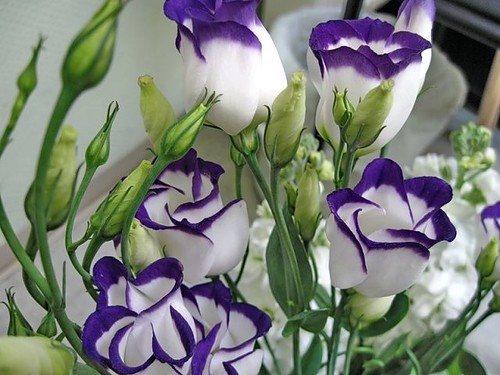

Features of planting eustoma in the open field
The optimal time for planting seedlings of plants on the site is the first days of July. In the middle of summer, young specimens will reach maximum readiness for rooting in street soil and will bloom almost immediately.
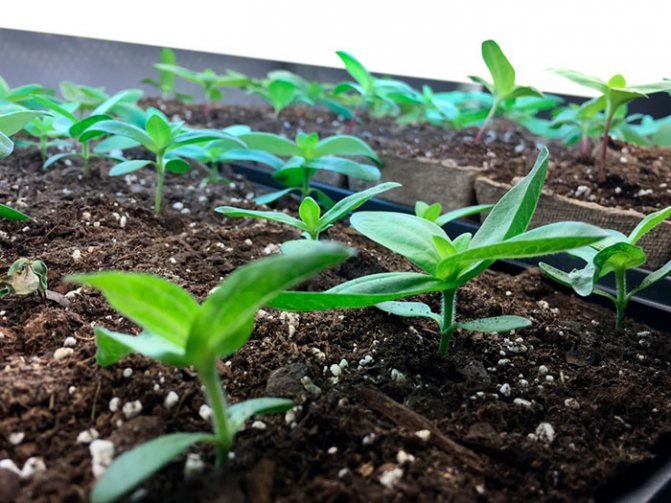

Eustoma shoots
For this to happen, consider the following when landing:
- Choose a place for the eustoma without exposure to midday sunlight - shade or partial shade.
- Do not plant the flower near objects that will reflect the rays of the sun on it.
- The interval between shoots is from 20 cm.
- The culture does not like high humidity and abundant watering. Do not plant it under the edge of a roof canopy or gutter to prevent water from stagnating in the ground when it rains.
- The garden soil at the planting site must have good drainage and a neutral reaction. Wood ash added directly to the holes will help to cope with increased acidity.
- Apply store-bought flower fertilizer or nitrophosphate to the seedling holes.
How the timing of the development of eustoma depends on the growing conditions
Like any aristocrat, the Irish rose is unhurried: the first shoots are cut when inexperienced gardeners lose hope. Development is considered normal, in which 10 days pass from the seeding of the seeds to the emergence of shoots.
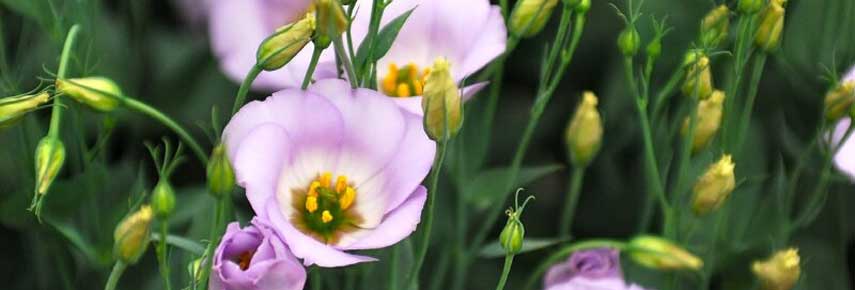

Ideally, the period from the appearance of the first shoots to the ejection of peduncles lasts approximately 25 weeks - 5.5 months. The duration of individual stages of a plant's life and a list of the main activities that should be carried out are given in the table.
When to plant and what seeds are best to choose
Eustoma differs from many plants in that it reproduces exclusively by seeds. This is due to the fact that cuttings never give roots, and an underdeveloped root system will not allow the plant to propagate by dividing the bush. As a result, it will simply die.
Seed growing of an Irish rose is a laborious process. The seeds are very small and do not have a high germination rate, it usually does not exceed 30%.
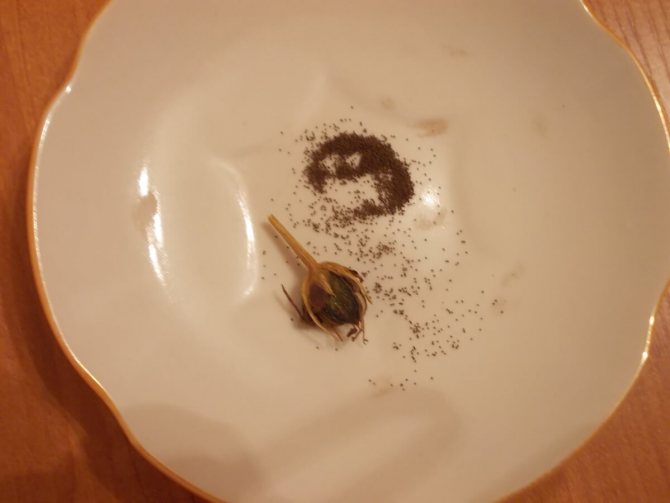

Eustoma seeds are extremely small and difficult to plant
Having decided to plant an eustoma, you must carefully select the seed:
- it is better to buy seeds from trusted producers and in specialized stores;
- you need to give preference to those that are treated with a special gel. This increases seed germination by up to 40% and simplifies the sowing process.
The timing of planting is influenced by the region in which the flower is grown, and the position of the moon at the time of planting. For the northern regions, the deadline is January, and in the southern climatic zone, seedlings can be planted in March.
Table. Favorable and unfavorable days for sowing in 2019 according to the lunar calendar
| Month | Auspicious days | Bad days |
| March | 7, 10, 11, 12, 14, 15, 16, 19, 20, 21 | 3, 4, 5, 6, 13, 17, 18, 22, 30, 31 |
| November | 9, 14, 21, 22 | 1, 2, 7, 14, 15, 23, 28, 29; |
| December | 3, 4, 5, 8, 9, 10, 11, 12, 27, 31 | 2, 3, 4, 7, 8, 10, 17-19, 21, 22, 23, 26 |
Landing dates
When to plant eustoma? This is the question most gardeners ask themselves. To determine the timing of planting, the following factors are important:
- The growing season of eustoma: shoots appear in 10-14 days, subject to the rules of agricultural technology; 2.5 months pass before transplanting seedlings, and another 8-10 weeks before flowering begins. Flowering lasts for 1.5-2 months - the buds open alternately, starting from the bottom of the stem.
- Growing method: in a greenhouse, in the open field, on a windowsill. With the greenhouse method, you can collect cut flowers 2 times a year. For spring cutting, for example, in early March, sowing seeds should be carried out in the first half of November; for cutting in May-June, seeds are sown in January; summer planting, early June.
- Climatic conditions (when landing in open ground): the maximum number of days with a temperature of 20-240C. Please note that at a higher temperature, up to 300C, seedlings bloom only in the second year.
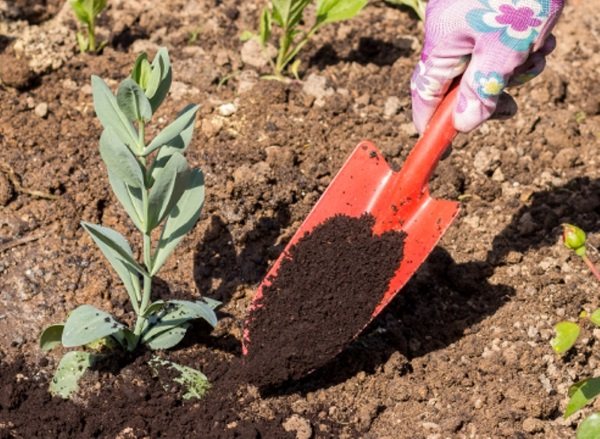

Before planting eustoma for seedlings, for further cultivation in the open field, study the calendar: the length of daylight hours should increase at the time of disembarkation to 11-12 hours, and the night temperature - up to 180C. Such conditions occur, depending on the climatic zones, at different times. The optimal timing for planting seedlings, when the specified conditions coincide: end of March or the first decade of April - for southern latitudes; from late April to mid-May - for temperate latitudes.
In the regions of Siberia and the Urals, it is possible to plant three-month seedlings in a permanent place using film shelters in the first half of May, in order to get flowering in July.
How to sow eustoma in peat tablets
For the ease and convenience of growing seeds, gardeners often use peat tablets. They are small washers that contain compressed peat, placed in special non-woven bags. They come in a variety of sizes. They are convenient because they contain the necessary minerals and nutrients.
So, you have purchased peat tablets for growing seedlings. Where do you start?
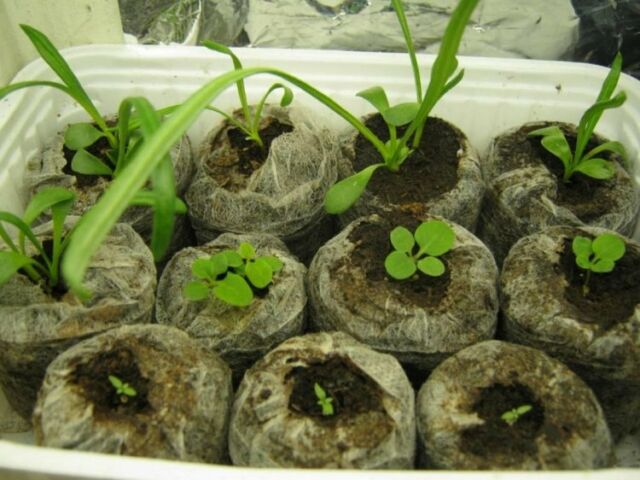

It is necessary to prepare the tablets, put them in a container and add water. It should be at room temperature. It takes about 30 minutes for them to soften and increase in volume. If water remains in the drawer, it must be discarded. Check that all the washers are in the correct position, there should be a hole on top for planting the seed.
Prepared seeds are placed 1 piece in the center of each washer. Since the seeds are small, tweezers or a wooden match or a toothpick can be used. Press the seed lightly. After all of them have been placed in the peat bags, sprinkle water over the tablets.
It has already been noted that seed germination is not too high. This may be facilitated by the fact that each seed is in a processed capsule. And the sprout sometimes lacks the strength to break it.
Therefore, there is such a method in which the shell is poured directly into the tablet with warm water, and then this very shell is carefully opened, lightly picking it up and making a crack.
Cover the top of the container with glass or foil so that the temperature and humidity are at optimal levels. In the future, watering is carried out at the slightest drying of the tablet by adding water to the bottom of the box with seedlings.
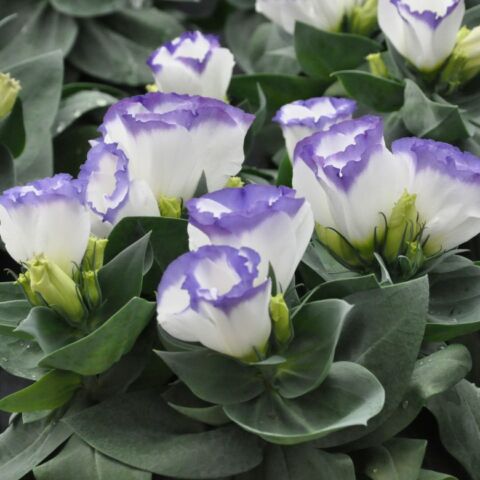

Of course, peat tablets have a number of advantages in use. After all, peat already contains the necessary level of acid, has antibacterial treatment, which reduces the risk of diseases of seedlings. Again, don't dive!
The tablet swells and grows with the seedlings without losing its shape. It is convenient to transplant it into a large container, or into open ground, without fear of damaging the root system of the plant.
Dormant period
For the winter, the plant significantly slows down its vital activity. After the flowers have completely fallen off, the stems should be cut off, while leaving up to three internodes. There is almost no need to water; plant pots should be kept in rooms with temperatures no higher than + 15 ° C. In the spring, the plant begins to wake up. As soon as the first signs of resumption of vital activity become noticeable, the eustoma must be carefully transplanted into a new container and the normal care regimen resumed.
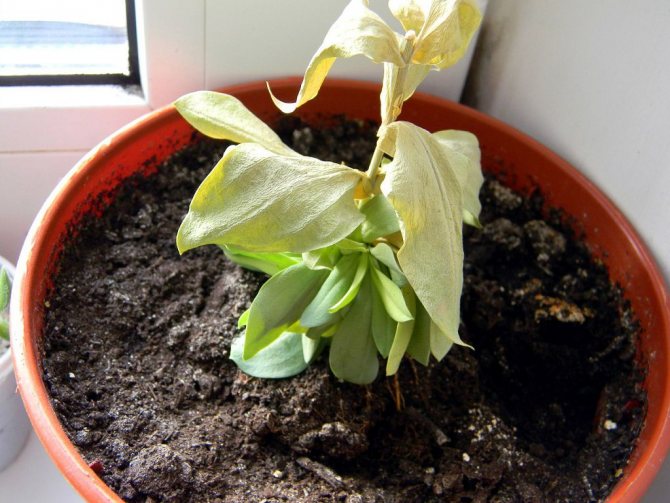

Eustoma in winter
Unfortunately, the withdrawal of flowers from the dormant period will not always be successful, especially for novice florists. To always have beautiful flowers in the room, keep seeds in stock. Plants have not come out of winter - start growing from seeds.
Sowing rules and useful tips
Before planting eustoma, it is important to choose the right soil. For this, a universal sterile mixture is sold in specialized stores, which is characterized by a slightly acidic or neutral reaction. For sowing, mixed decayed bark of deciduous trees is suitable in equal proportion to peat, or peat tablets soaked during the day are used.
Sowing rules:
- The soil in the sowing container must be moist and soft. To do this, the soil must be leveled and slightly compacted, and then sprayed with water from a spray bottle.
- Seeds are spread over the surface at an equal distance from each other (2-3 cm) using a toothpick soaked in water. The seeds are not sprinkled with earth, but only slightly pressed.
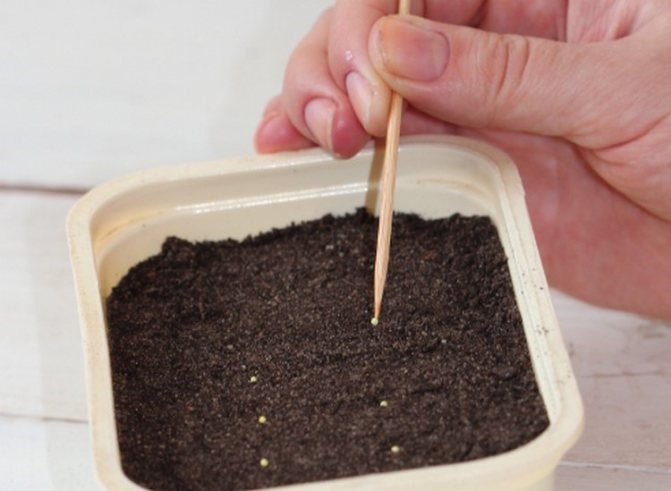

- Cover the top of the pot with cling film, plastic bag or plastic lid. For the free flow of air into the greenhouse, it is necessary to make several holes in the film with a needle or a toothpick.
- After germination (after about 15 days), the greenhouse is completely removed.
Watering seeds and seedlings must be done with a spray bottle. To prevent the development of rot or fungus, spraying with phytosporin is performed.
Description of eustoma flower
Strong and graceful stems resemble carnation stems in their structure and can reach a height of about a meter. The branch looks like a real bouquet due to the excessive branching of the stems.The number of buds on one branch fluctuates about 35 pieces, which bloom, replacing each other. The leaves, gray or bluish with a matte finish, have an elongated oval appearance. Large flowers are funnel-shaped, cups are 5-8 cm in diameter. There are pink, lilac, white and purple buds. They can be the same color or have contrasting edging around the edges of the calyx. The half-open flower slightly resembles a rosebud, and the fully open one resembles a poppy. Eustoma growing in its natural habitat is considered a biennial plant. The horticultural period only takes one season. In a flowerpot, she can live for about 4-5 years, and for open ground, her life span is reduced to several years.
How to propagate
Since it is difficult to divide the shrub, using the vegetative method is not encouraged. Also, the delicate root system is not easy to divide without damaging it.
The French rose is usually seed-propagated, and there were times when it was nearly impossible to find eustoma seeds. Nowadays, you can easily buy the most suitable plant species for you.
After purchasing the seedlings, you should not waste precious time, but start sowing as soon as possible, because the acquired material must be planted on time.
Once your flowers have grown, you can harvest the seeds with your own hands.
Seed planting and care
Having become the owner of the most beautiful flowering shrub, it is necessary to prepare it for planting in the soil. Remember that the soil must be sterilized by steaming it or using hot potassium permanganate for this purpose. You can also use peat tablets, which are equally effective.
It is worth abandoning the roasting of the earth in the oven, which some of the gardeners like to use. Due to this method, the nutrients contained in it will be lost, and the French rose without eustoma thorns is too sensitive and may die in such soil.
- It is worth sowing seeds in disposable cups or special boxes for seedlings with cells.
- Cover them with earth and slightly moisten it.
- Place the seedlings on the surface of the soil and press them lightly.
- In one glass, with the help of a match or a toothpick, no more than 3 seeds are placed, if we are talking about cells, then only 1 pc.
- Be sure to stretch polyethylene over the glasses, which will create a kind of greenhouse.
From now on, you should wait for the first shoots to appear. As a rule, seedlings are sown in the first days of February or March.
In the event that you decide to sow them later, you will hardly be able to see their flowering. At the time of germination, be sure to observe the temperature, which should correspond to 20-25 degrees.
How to care for seedlings
Eustoma growing from seed, when the time comes to plant, needs some care.
- The first thing you need to do regularly is to air the sprouted seeds at least once a week. This will allow the condensate to evaporate.
- In addition, airing will allow you to find out in time whether the seedlings need watering or not. If you notice that the soil is a little dry, it is worth moistening it with a thin stream of water, which is poured along the edge of the glass.
- When all the necessary procedures have been carried out, be sure to cover the young plants.
Eustoma flowers growing from seeds at home you already know how and when to sow. Now is the time to learn how to properly care for the seedlings.
- From the first days of planting, you need to carefully monitor future bushes.
- If you grow them in the house, then lack of lighting can lead to stretching of seedlings... To avoid this, it is necessary to provide them with diffused light.
- In the last weeks of February, be sure to transfer the seedling container to the southern windowsill. As soon as the sun's rays warm up the lisianthus, it will begin to grow more actively.
- After about 3 weeks, sprouts will begin to sprout.
- After they reach 2 cm, you need to do a dive. But remember that this procedure is carried out with extreme caution, since the Irish rose is very delicate and can be easily damaged.
Growing in peat tablets
This method is quite popular, because thanks to such tablets, lisianthus germinates much better. In addition, it will be much easier for you to transplant the plant into open ground. Eustoma or Irish rose will thrive in 5cm peat tablets, which should be placed in containers.
- First you need slightly moisten the pill without letting it swell... Never leave water in it.
- Using tweezers, place the seedlings in the tablets and press down lightly.
- Use a spray bottle to moisten the seedlings.
- As soon as several leaves appear, you need to send the tablets to a special container.
- It is very important to ensure that the root system of neighboring seedlings does not intertwine.
Next, take care of the plants, as well as the bushes growing in the garden. Eustoma long-term planting and care in Siberia is carried out almost the same as in other regions of the country.
Seedling picking
A few months after the seedlings have been planted, they can be dived into personal containers. But this procedure should be carried out carefully so as not to harm the sprouts.
Transplant rules
- In order not to harm Lisianthus, it is customary to use a thin awl for transplanting. With its help, thin young plants are hooked up and transferred to separate cups.
- But do not forget to prepare the soil in the container in advance and make holes in it using a pencil. Deepen the flowers to the very leaves.
- Water the soil before transplanting, and after it is completed, it is worth covering the young plants for a few weeks, which will allow them to take root.
Seedlings easily cope with transplanting, therefore, after a few days, they actively begin to grow.
How to properly water seedlings
Eustoma long-term planting and care of a photo showing the simplicity of this procedure requires some nuances from gardeners when watering seedlings.
Important! The first thing to remember for novice growers is that the soil should be moistened with extreme caution. Only young shoots that have appeared should be watered only in the morning, which will avoid such a disease as black leg, which affects young shoots. Why? Yes, just in a day, the soil has time to dry out and excess moisture does not accumulate, which provokes a black leg.
Also, do not forget to get rid of infected sprouts, because you cannot cure them. In addition, if you leave them near healthy plants, they can become infected. Covering each glass in a separate bag will help prevent infection.
Since Lisianthus is very delicate and is constantly in moist soil, the risk of contracting the disease is too great for him. Do not forget to take into account that the first shoots are very sensitive to changes in air temperature and drafts. That is why, when installing the container in a certain place, make sure that nothing will threaten it.
Root planting
When acquiring roots, be careful, as they have many elements. similarities with phlox and hosts, and many sellers can sell them to you instead of lisianthus.
Eustoma is sometimes rooted in autumn. Quite delicate roots, very easy to damage, so if you do not want the plants to die, carry out this procedure with extreme caution. Eustoma propagation by cuttings and dividing bushes is also not encouraged due to the tenderness of the roots, which can be damaged during transplantation.
How to plant in open ground
Choose a well-lit place where there will be no drafts or cold winds before planting out into the garden. The bushes should be transplanted on cloudy days, observing the intervals between young shoots of about 20 cm.
- Rolling over the earthen lump of each bush, it is necessary to move them to the previously prepared holes.
- Once the procedure is over, cover the bush with a transparent plastic bottle cut into two parts.
- Thanks to such peculiar greenhouses, you can protect the eustoma from return frosts, direct sunlight, and also prevent moisture from evaporating.
- When you are sure that the frosts have passed and will never return, get rid of the shelter.
- After 4 weeks, the plants will take root and at this point you need to start feeding them.
Important! Remember, the Irish eustoma rose prefers a versatile fertilizer used for flowering plants. But at the same time, the concentration of the solution should be reduced by 25% than indicated on the package. For this purpose, it is recommended to use Plantafol, Kemir, Kemira Lux.
Based on the time at which the change was sown, the time comes when the first flowers on the plant will begin to bloom. Around July, seedlings take root in the plots where they were planted. After a while, flowers begin to bloom. Flowering lasts until the first frost.
Propagation by cuttings
Remember that eustoma does not tolerate cuttings, so you should not use this method for propagation. Be sure to spray your seedlings so that they are not attacked by such an ailment as a black leg. If you do not do this, then the bush will certainly die.
To enjoy the lush flowering of Lisianthus, be sure to prune the shoots after the first wave of flowering is over.
Recommended varieties for growing
The popularity of eustoma in Russia is only gaining momentum. It is enough to ask about the rating of flower varieties in the most famous specialized stores, and you can understand which flowers of this type attract the most attention. Just to begin with, you need to decide which of the growing methods is an acceptable option.
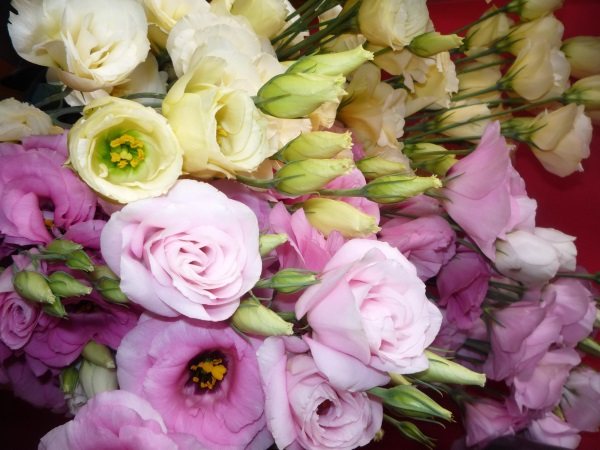

So, the top 9 most popular eustoma varieties:
Low-growing varieties, for pot cultivation, border decoration:
- Carmen F1 Ivory (stem height 25 cm);
- Sapphire F 1, white-pink, height 20 cm;
- Mermaid F1 - all colors.
Medium-sized varieties and hybrids for garden decoration:
- Twinkies F 1 (white, cream, purple, yellow, pink);
- Cinderella F1.
Flowers for cutting are in the greatest demand, with a stem length of 70-100 cm.Therefore, they are most widely represented in every flower shop and well-known agricultural company:
- Magic F 1 terry (hybrid is represented by a series of various colors);
- Hybrid Green alley with an unusual pistachio shade;
- Flamenco F 1;
- Terry apricot.
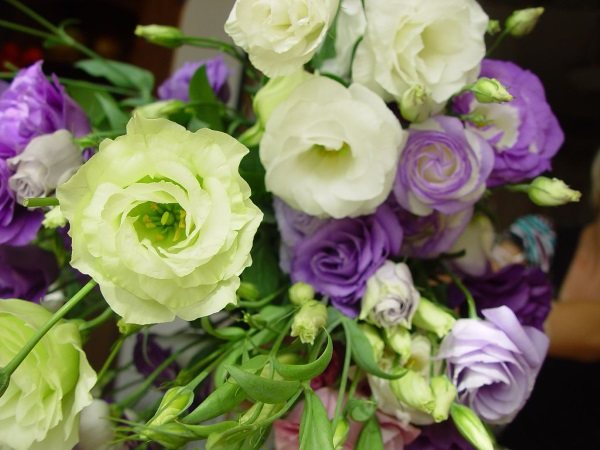

Other varieties
Low-growing varieties of Eustoma include:
- Eustoma Riddle is a low compact bush, reaches 20 cm in height. It blooms profusely with double light blue flowers.
- The Mermaid variety is a miniature compact species of Lisianthus, the crown height of which does not exceed 15 cm. It does not need to be pinched. This hybrid blooms with simple flowers with a diameter of up to 6 cm in various shades: white, light pink, lilac and blue.
- Little Bell is a densely branching bush of miniature size, reaching a height of 15 cm. The flowers are small, simple, funnel-shaped, of all kinds of coloring. This variety is prized for its abundant long flowering. You don't need to pinch.
- Eustoma Fidelity is a short houseplant, no higher than 20 cm in height. Differs in many snow-white small flowers, which are arranged spirally on the flower arrow.
- Variety Tenderness is a beautiful bush with a graceful stem up to 20 cm, on which satin petals are arranged in a spiral. Blooms with pink flowers.
- The little mermaid has very small bushes, up to 15 cm in height, bloom with white, light blue or pink flowers.
- Eustoma "Florida Blue" - is distinguished by abundant flowering of blue flowers.
- Florida Pink variety - this very beautiful, low indoor flower blooms profusely with light pink flowers. Looks in a pot like a bouquet with wonderful miniature roses.
Flowers - for every taste! True, we must not forget that hybrids, decorating the garden during the season, will not give full-fledged seed material. Therefore, the seeds of the kind you like will have to be bought, and not collected.
Stages of cultivation of lisianthus
| Seed germination temperature | Duration of daylight hours | Emergence of seedlings | Picking | Landing in the ground | Peduncle development |
| 14-20 ° C | 12 hours | 7-12 days | The emergence of the 2nd true leaf - 45 days after germination | The appearance of the 8th true leaf - 3 months after the pick | 6-12 days after rooting |
When setting the sowing date, it is advisable to take into account the weather characteristics of the region and the type of microclimate in the house. It is good if you already have experience in growing a flower.
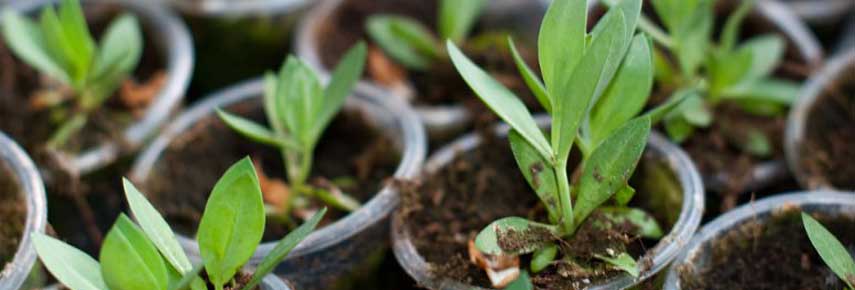

Experienced growers usually plant the seeds of bushes that will have to move to the garden at least six months before flowering. Without practice, it is better to play it safe and sow lisianthus in October-November.
In reality, the timing of the onset of certain events in the life of an eustoma can shift in time. The reason is possible delays in flower development. A list of factors affecting the growth of eustoma, and tips on how to calculate the time to start growing it, are given below.
Let's analyze the situations:
- When planting seeds, due to unstable temperature, light and humidity conditions, seedlings can emerge on the 20th day or even later.
- One of the common, but harmless reasons can be an unopened dragee shell. It sometimes has to be destroyed by hand with a toothpick.
- Further: when picking, the plant stops in development for 1 month. Thin, very long roots do not adapt well to new conditions. While the eustoma is young, it undergoes a transplant. An adult plant dies if the dive rules are violated.
- It would be more correct to call the transplanting of the formed seedlings a transfer: the plant should be transferred to a new habitat together with the soil - with an earthen clod. But even in these conditions, growth retardation is possible.
The reason is simple: the flowers grew in pots, the root system is accustomed to greenhouse soil. After moving to a flower bed, the bush will have to grow up: the growing roots will have to adapt to the real fertility of the natural soil and to the climate. Adaptation can take up to a month. The possible delay in this case should also be taken into account when planning the landing.
Taking into account the above factors, it is more expedient to carry out an earlier planting of seeds. If the eustoma blooms before June, it will show off in containers in the house. After the arrival of real heat, the flowerpots can be taken out into the garden. The total flowering period will last from 3 months to 4 months.
Worse if you are late with the deadlines. Late planting will lead to the peak flowering of the regal beauty will be in September or October. Without additional light at low temperatures, the flowering period will be reduced to a few days.
Flowering secrets
Often, novice flower growers are interested in why indoor eustoma blooms poorly? Growing and caring for this magnificent plant is fraught with some secrets:
- a few minutes after watering, drain the water from the pan;
- so that the plant blooms more abundantly, maintain the temperature regime necessary for it and ventilate the room more often;
- if pests are found on a flower, start treatment immediately to prevent their spread to other plants.
Growing problems
| Problem | The reasons | Control measures |
| Susceptible to diseases of gray mold, powdery mildew, fusarium wilting. | High humidity, cold. | Spraying with Topsin and Saprol preparations. Different means alternate. For prophylaxis, the treatment of healthy plants is recommended. |
| It is affected by mushroom mosquitoes, aphids, whiteflies, slugs. | Proximity to infected plants, inadequate care. | Treatment with Fitoverm, Mospilan, Confidor solutions. |
Eustoma grows well in the garden. Tall varieties with abundant flowering are more suitable for flower beds. Looks spectacular both by itself and as part of flower arrangements.
How to grow eustoma at home
Eustoma is a flora with amazingly beautiful flowers of delicate shades. They are often added to bouquets - they stand for a long time, do not fade. This plant also has a minus - it is quite capricious, requires a lot of attention to itself. The color of this flora is very similar to pink, which is why sometimes it is called that - Irish or Japanese rose.
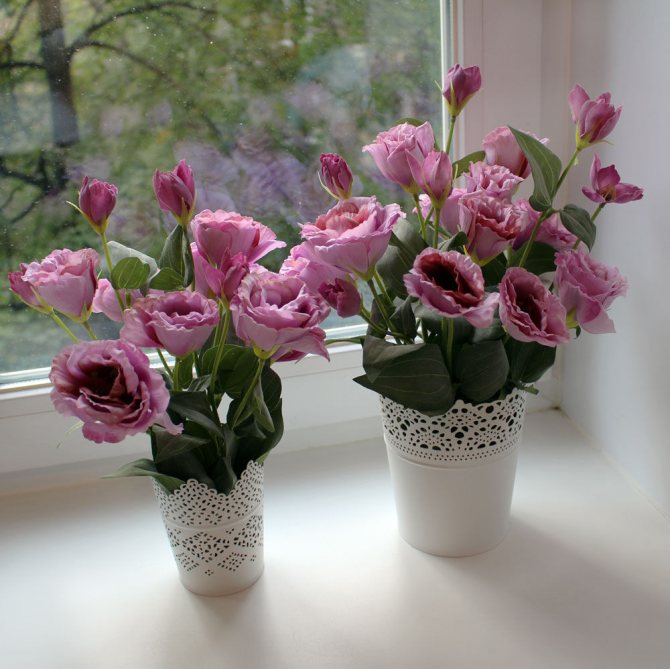

Indoor eustoma
Important! Some people wonder if eustoma can be grown as a houseplant. The answer to it is positive: it is grown both in the garden and at home. What is remarkable is that the same species is used everywhere - the large-flowered eustoma, or eustoma grandiflorum. She is now called Lisianthus Russell.
In height, an adult lisianthus bush is from 15 to 90 centimeters, during the flowering period it releases about twenty flowers. They do not dissolve at the same time, but one after the other. Because of this, the beauty of the blooming flora is preserved for a rather long period.
Until recently, this culture was considered a garden or greenhouse. Today, eustoma can often be found in the home. Preparing to acquire such a flower, need to consider the following:
- In nature, lisianthus is a perennial plant. In the house he is often kept only during the flowering season. For the winter, he needs conditions, which are quite difficult to recreate in an apartment. Even if it succeeds, a full-fledged perennial at home cannot be made from it.
- Be sure to clarify what kind of flowers it is. A home needs crops that can survive in pots. They shouldn't grow taller than 30 centimeters.
- Most likely, after the purchase, a bush, even a dwarf one, will begin to grow in breadth and upward. This is because in order to speed up and reduce the cost of the growing process, plants are fertilized with growth inhibitors.
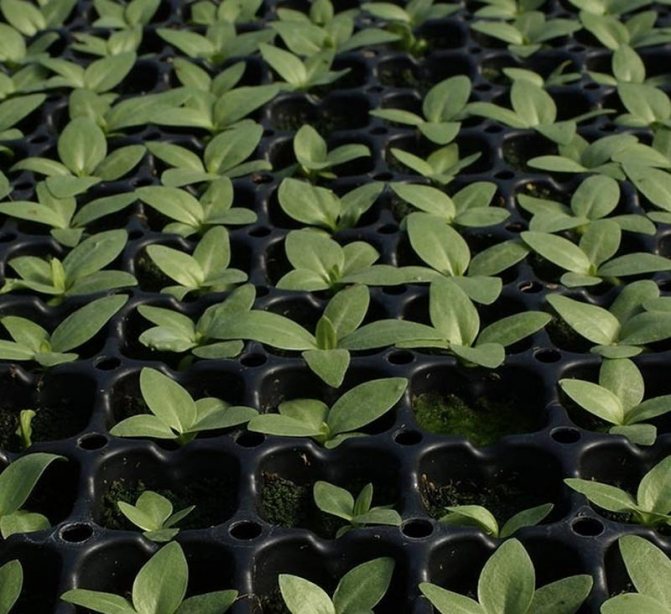

Sale of eustoma seedlings
To avoid the latter, you can grow this flora at home on your own. It is best to start from scratch, that is, germinate the seed.
How to properly care for eustoma
In caring for an ornamental plant, it is important to maintain the level of soil drainage by regularly loosening and removing weeds. It is not necessary to water the eustoma with a large amount of water: small, but regular doses are enough. Drip irrigation is ideal for this flower. After watering, be sure to cover the root zone with mulch. If you go through with the volume of water, the root of the plant will surely be affected by the fungus. If the soil is too dry, the eustoma will shed its buds.
Attention! Watering is carried out strictly on the plant.
Other nuances of proper flower care:
- Up to twice a month, he needs a light feeding with complex fertilizers.
- The stems of tall varieties are not strong enough to hold a ripe bud. Tie them to a support.
- To prolong flowering, check and remove faded or tainted buds.
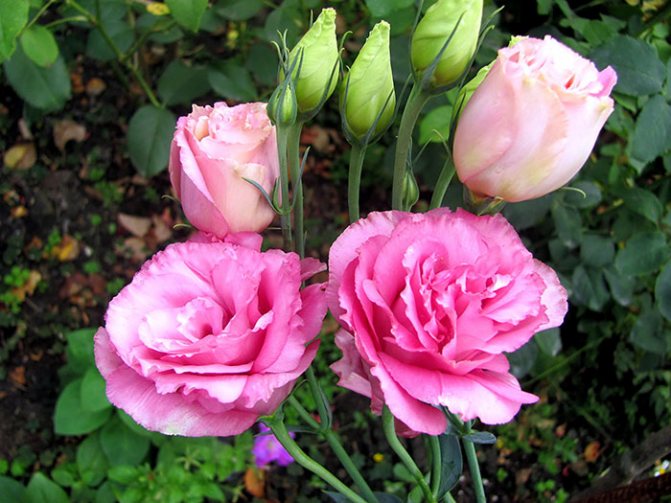

Blooming eustoma may need support
The flower dies even with minimal frost. To preserve the plant for next season, transplant it into a container filled with garden soil in October. Further, two ways are possible:
- Move the container to the room. Flowering may continue, although not as intensely as in summer.
- Trim the peduncles so that only a couple of internodes remain on them. Place the container in a bright room with low humidity at a temperature of about + 10 ° C. Water while keeping the soil slightly moist. Increase the dose of water in February.
In early summer, the flower can be returned to an area under the open sky.Be prepared for the fact that when moving from the street to a warm room, the plant may begin to wither. Don't be alarmed, this is an adaptation. To help the flower overcome stress, keep watering to a minimum.
Attention! In the second season, eustoma blooms less.

